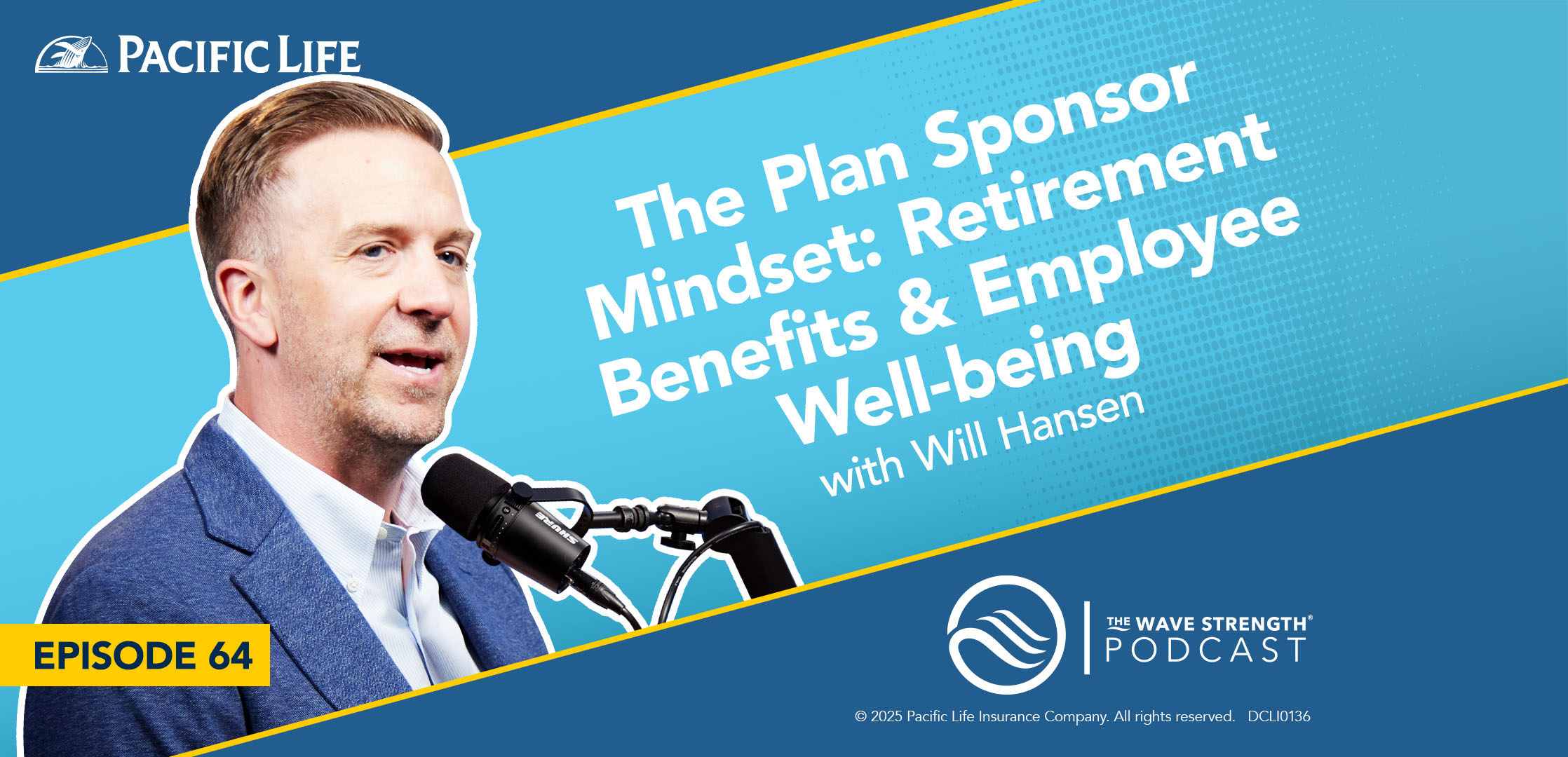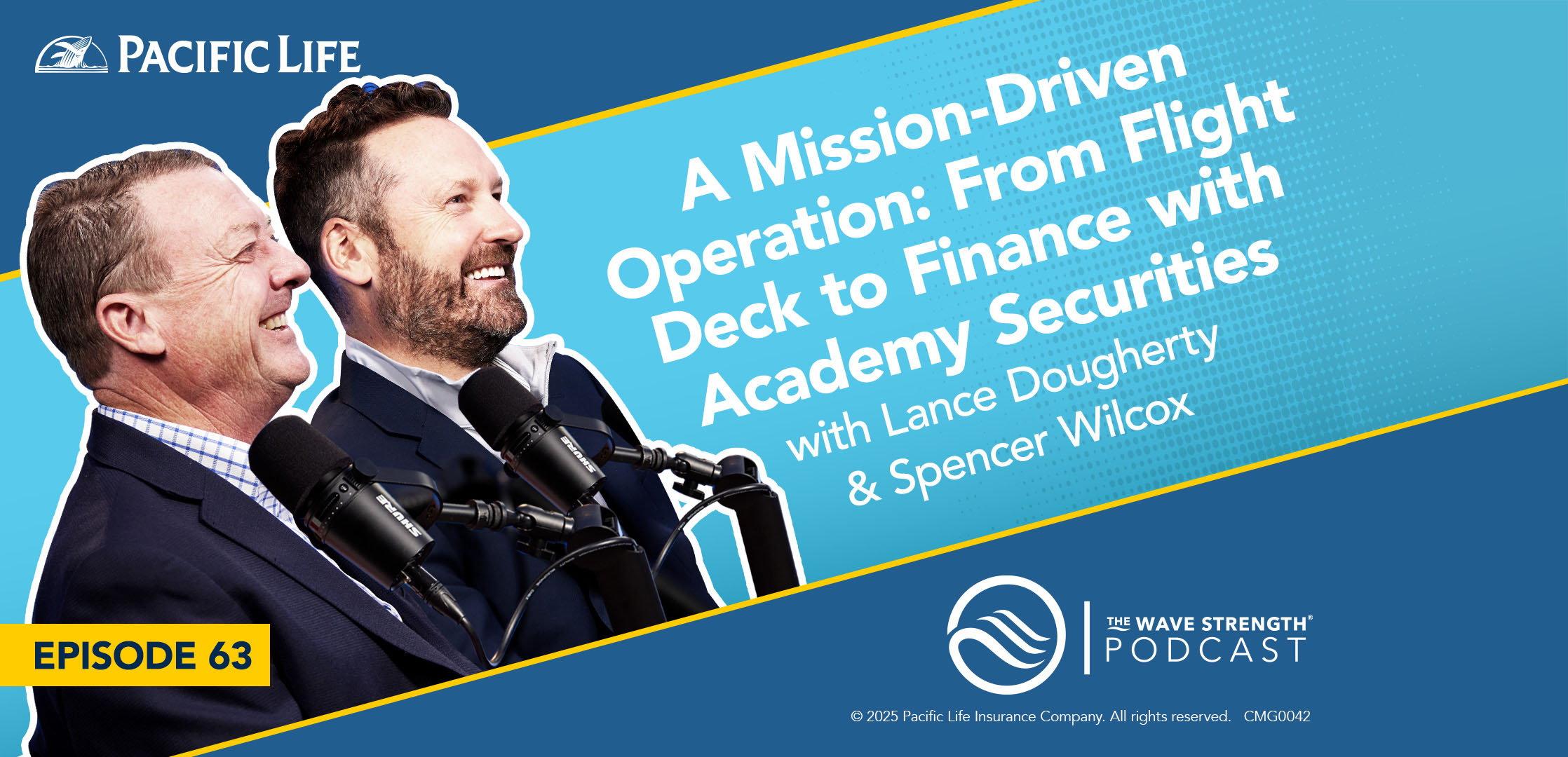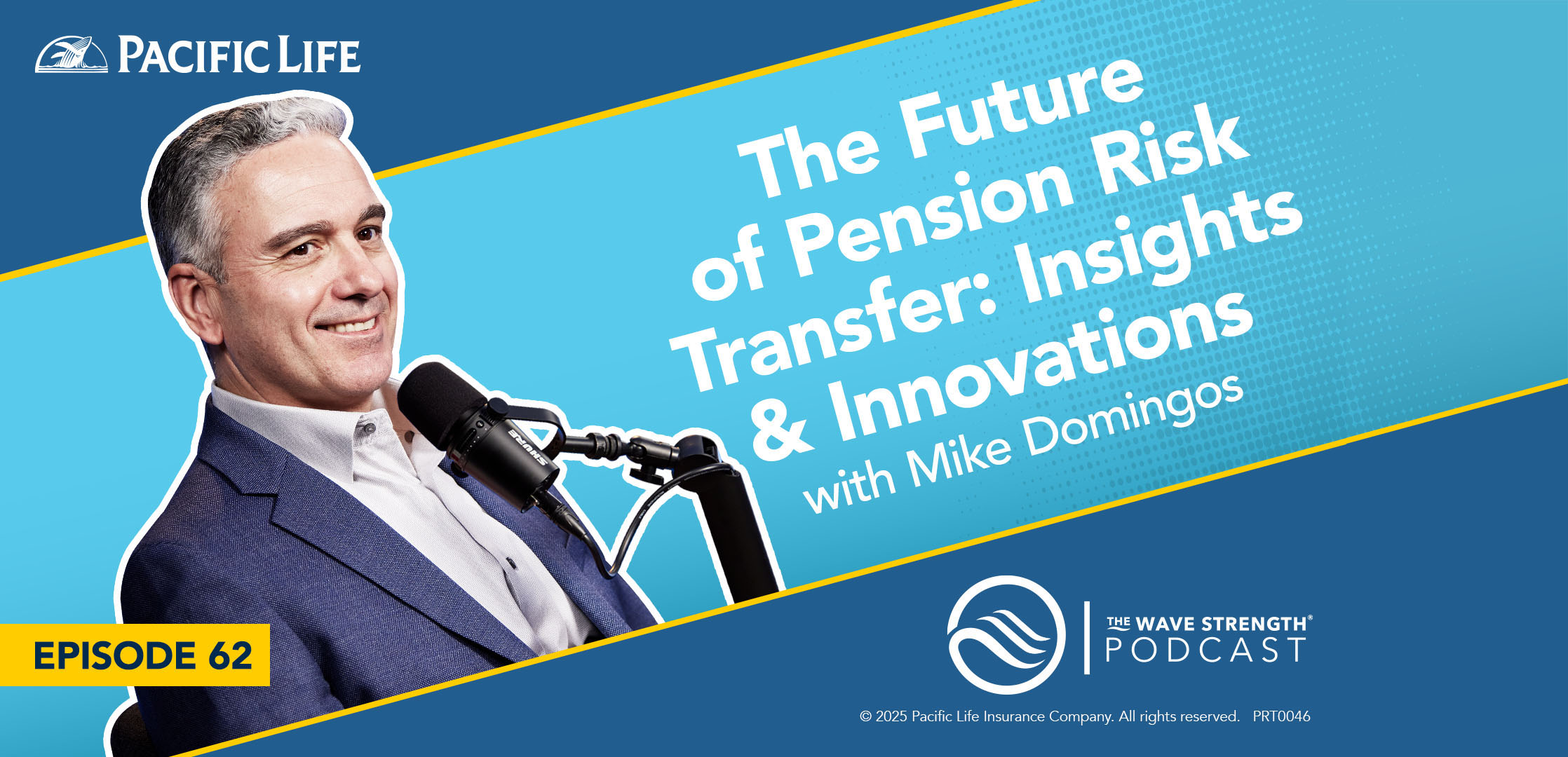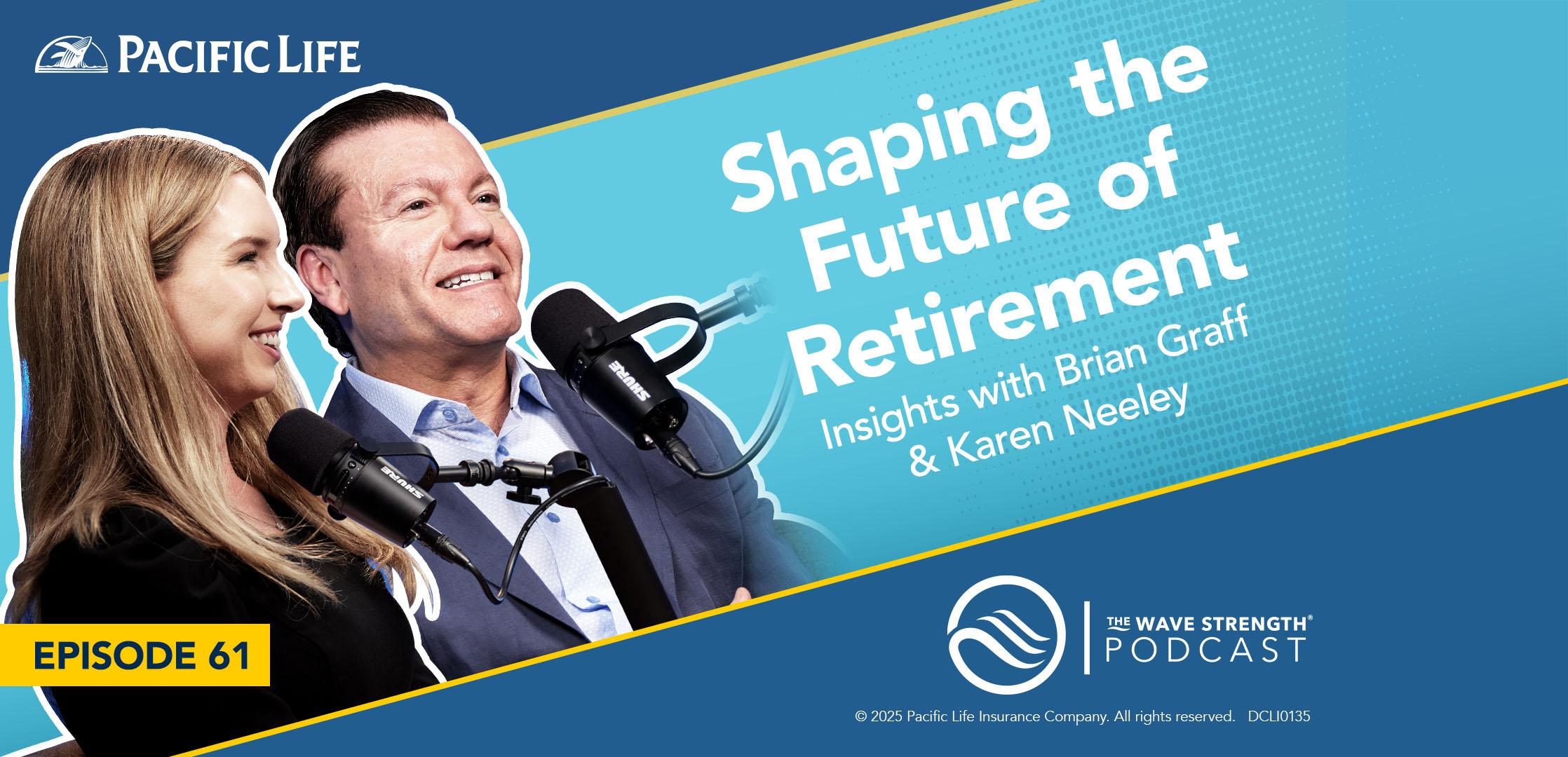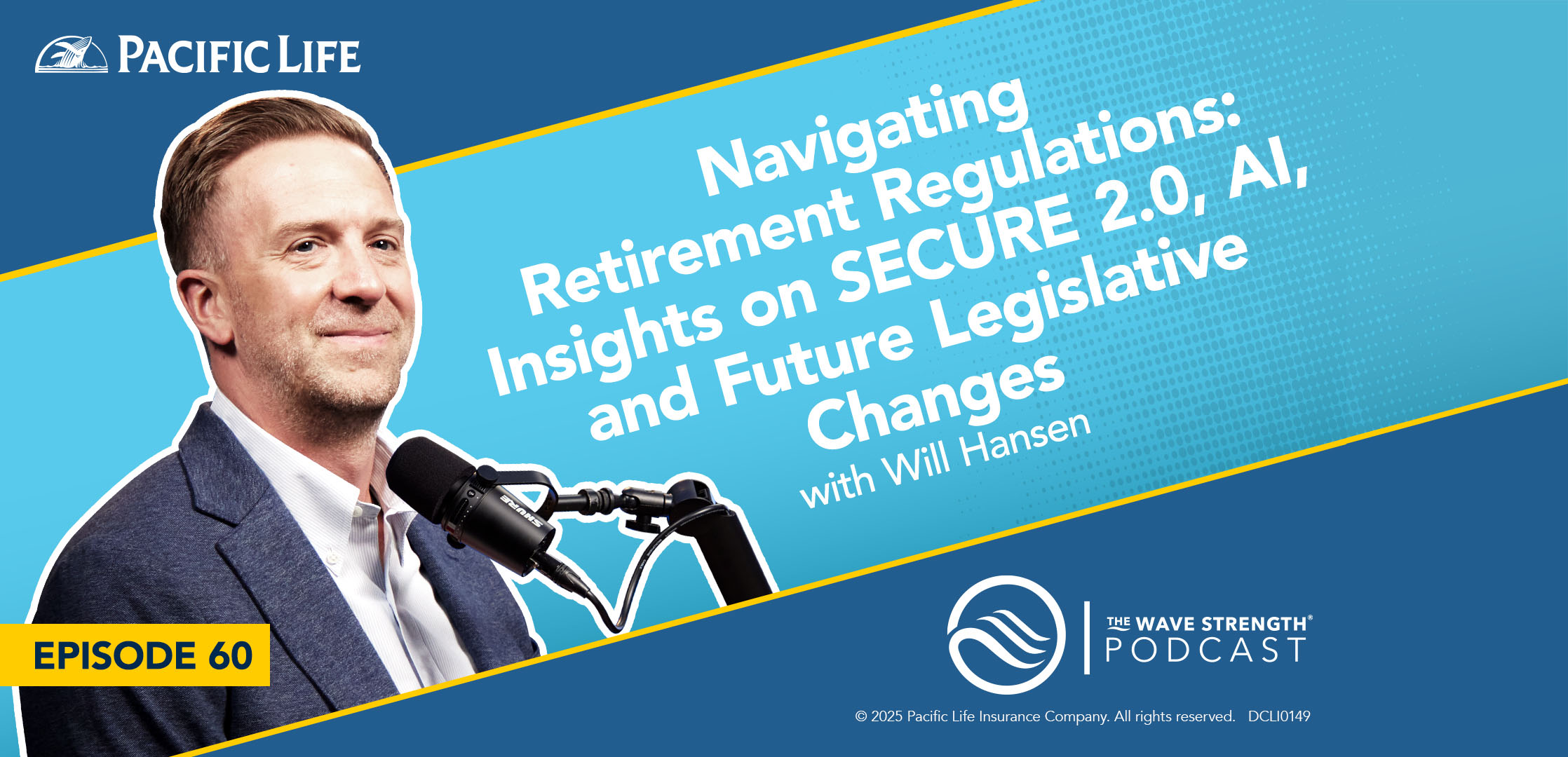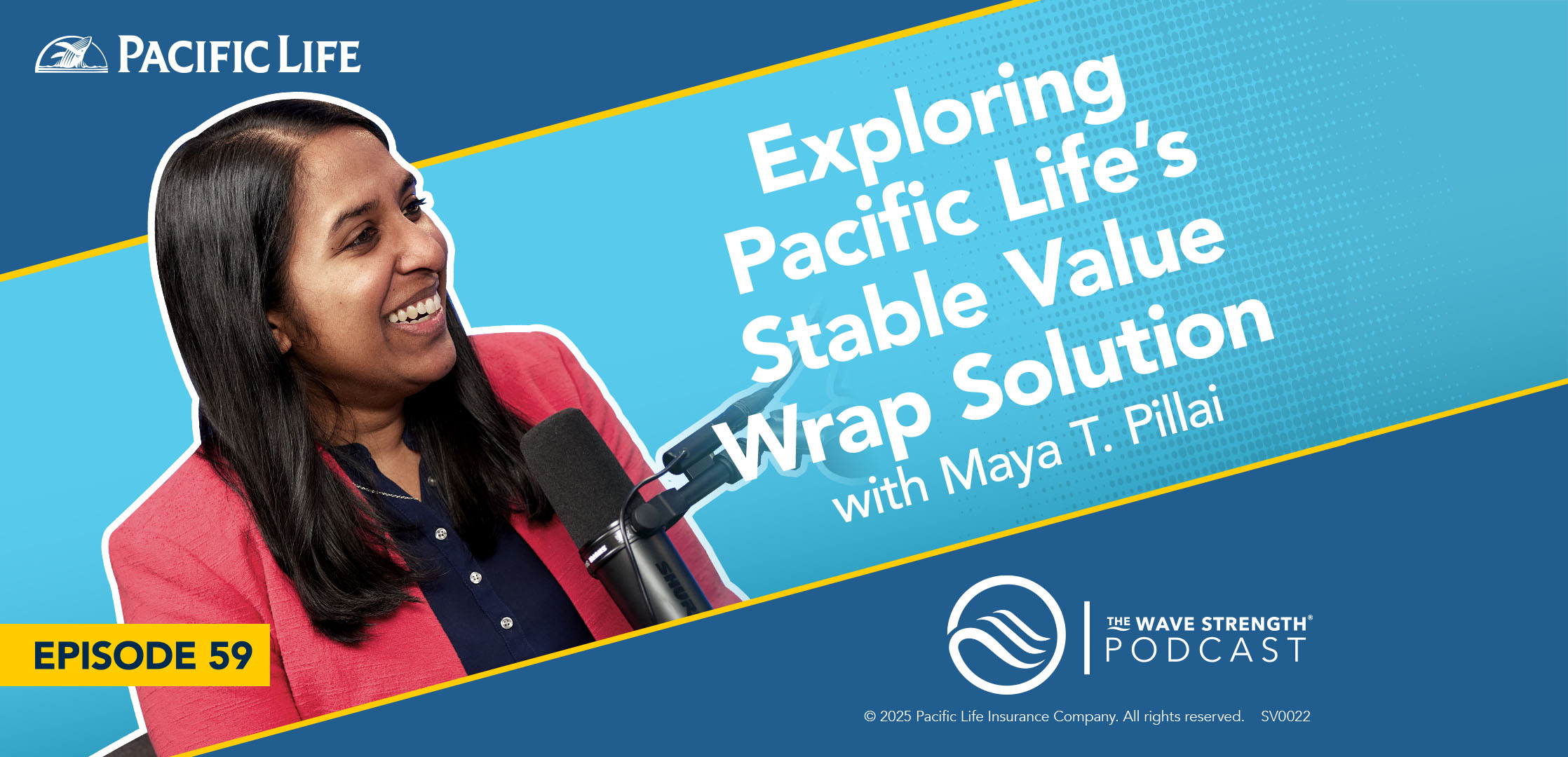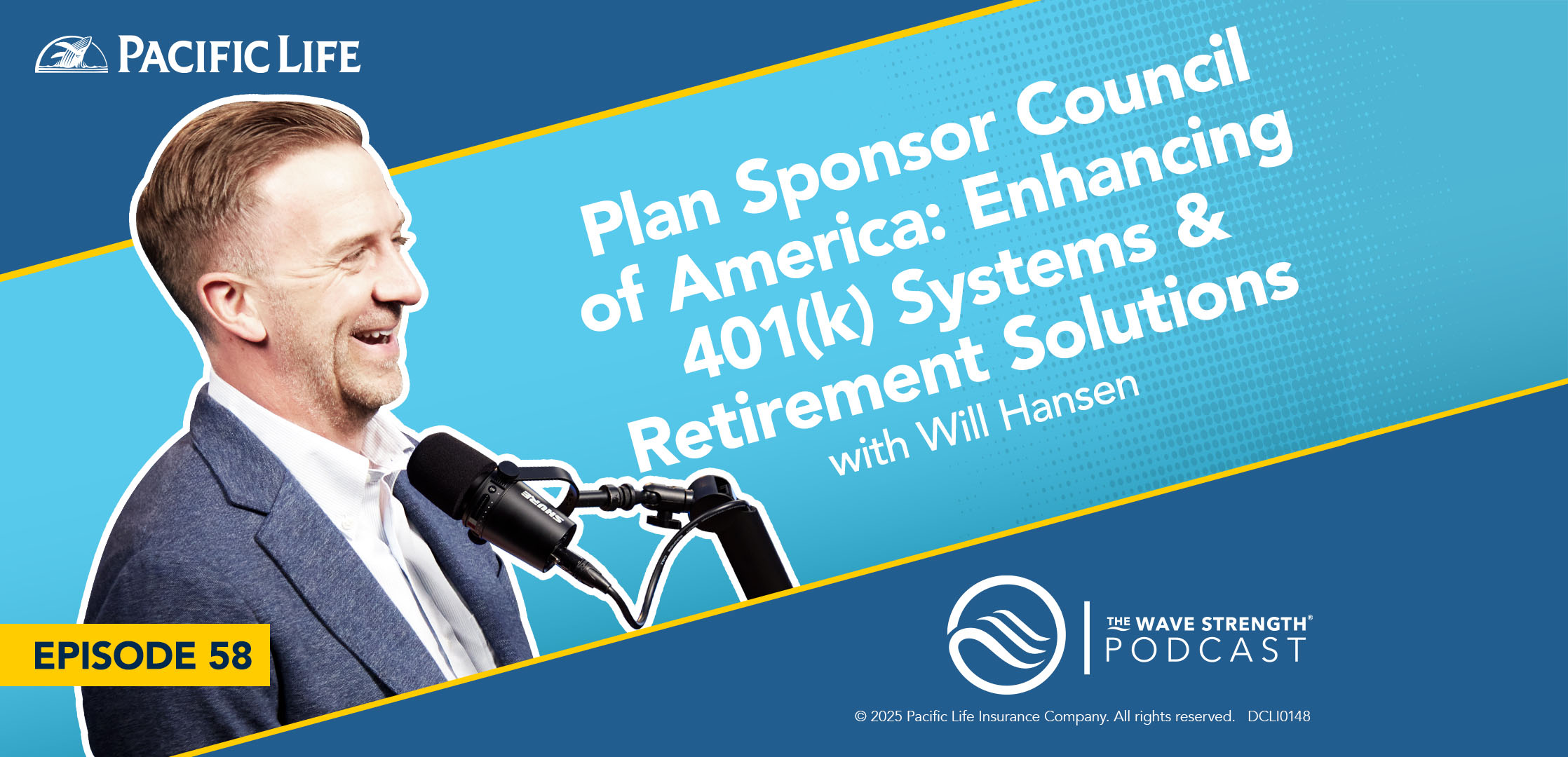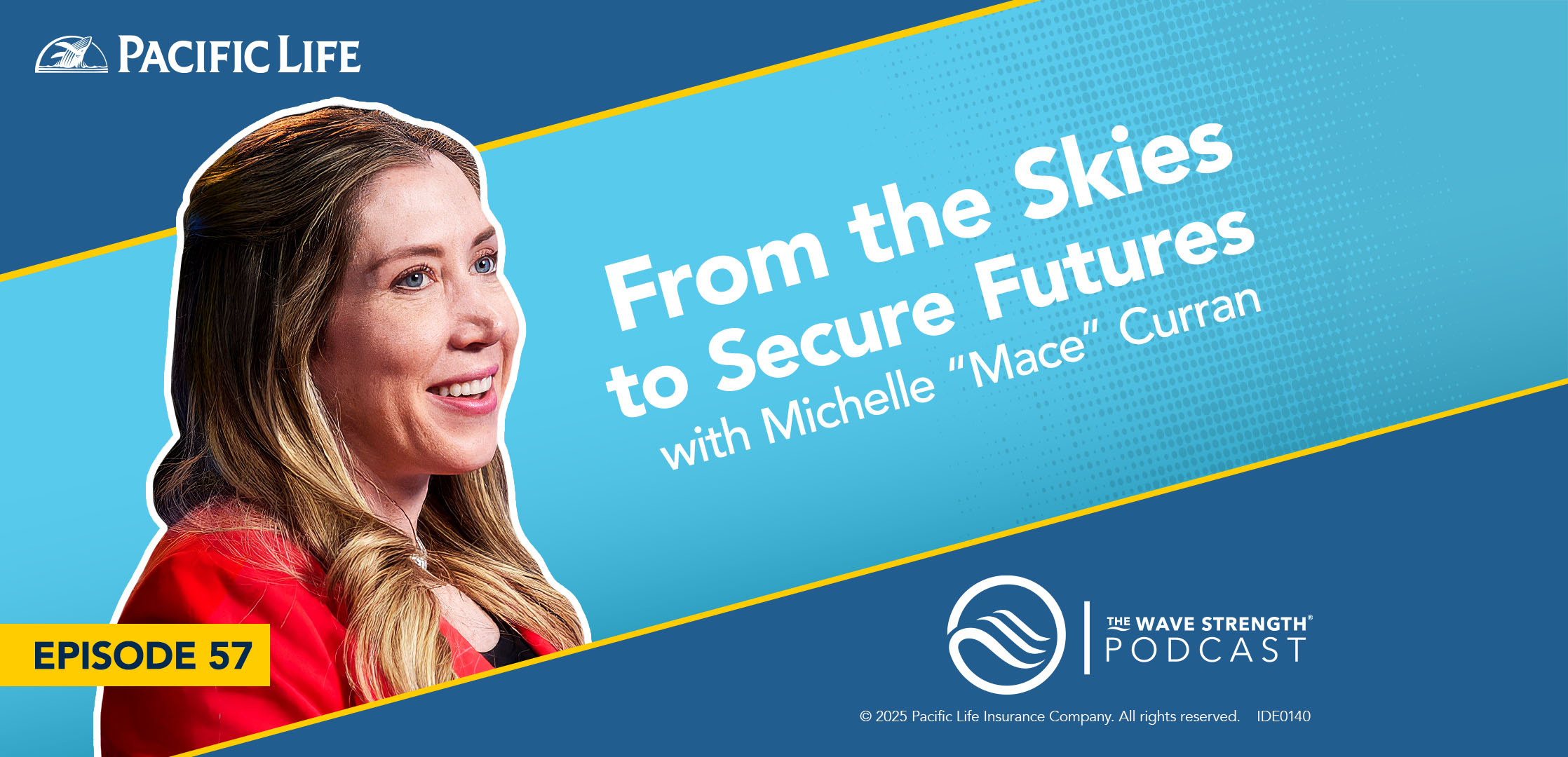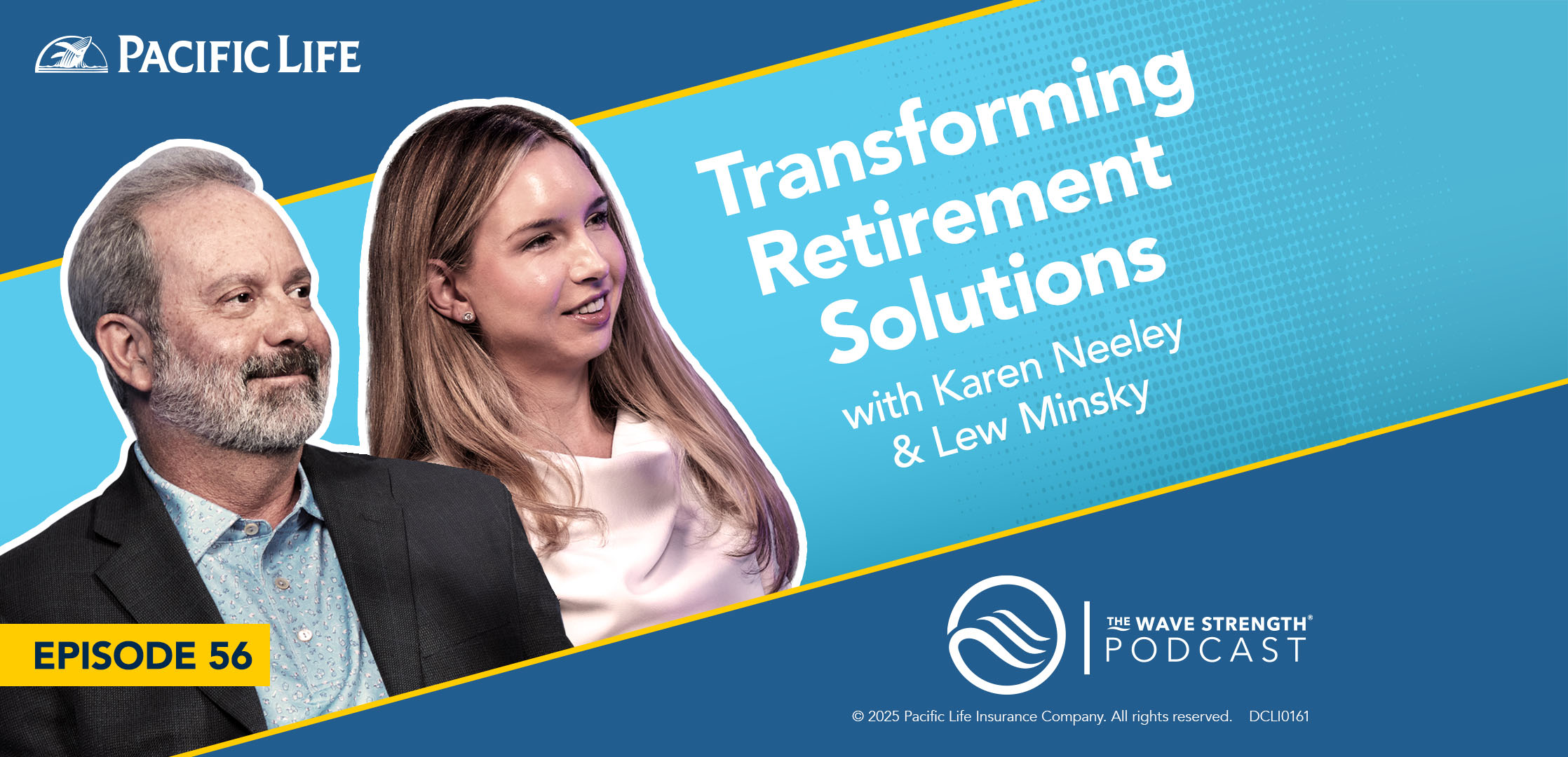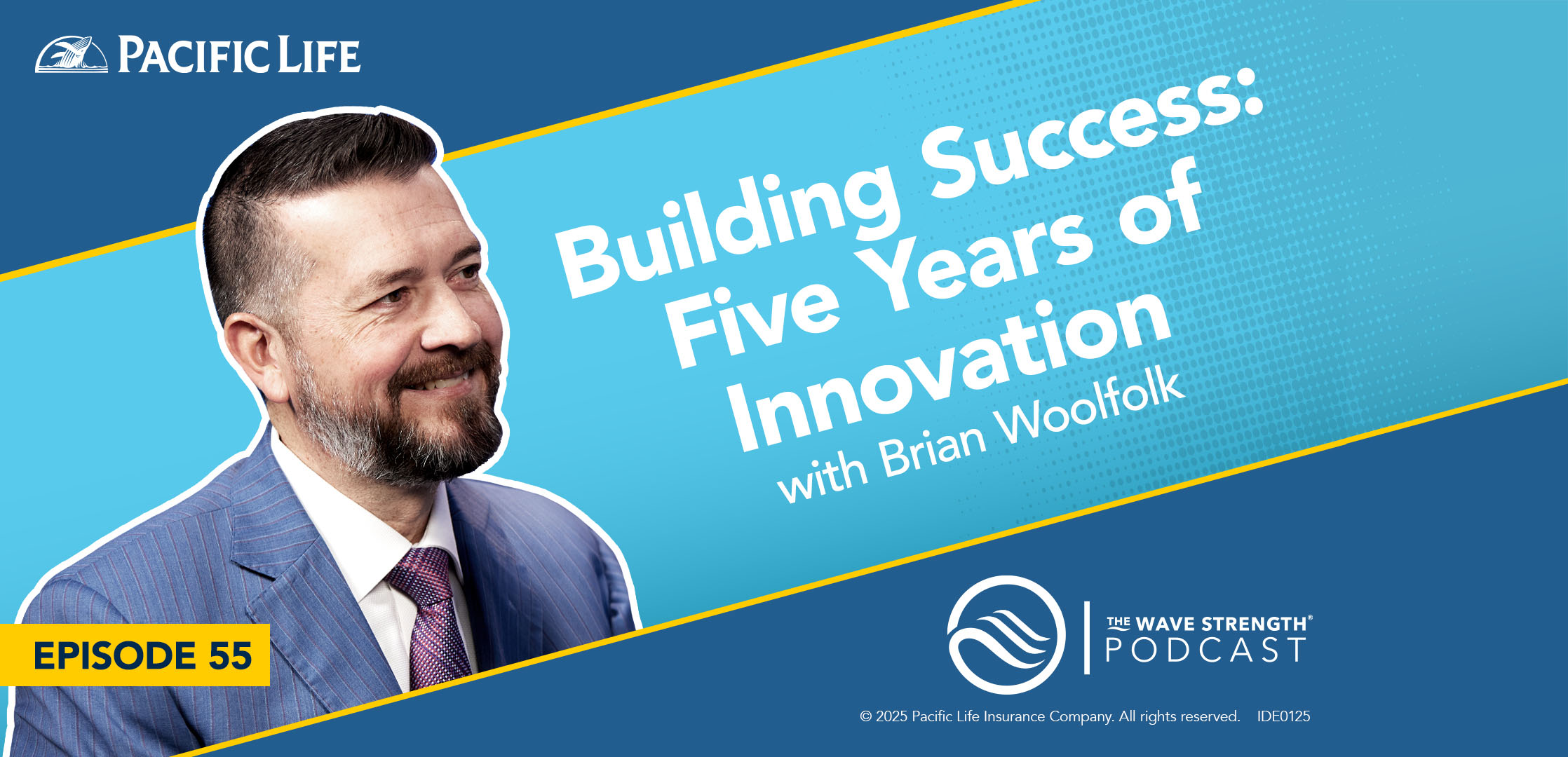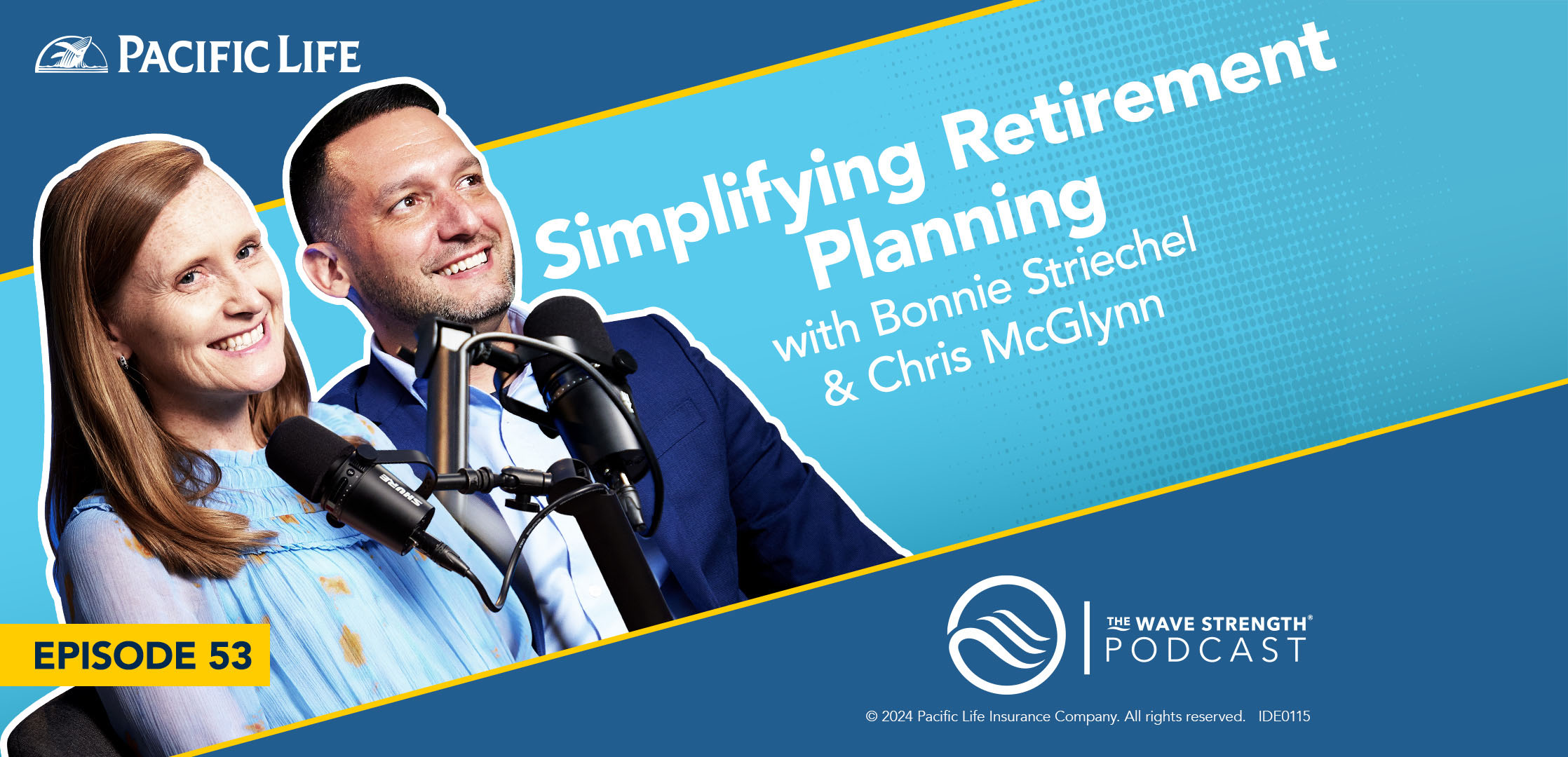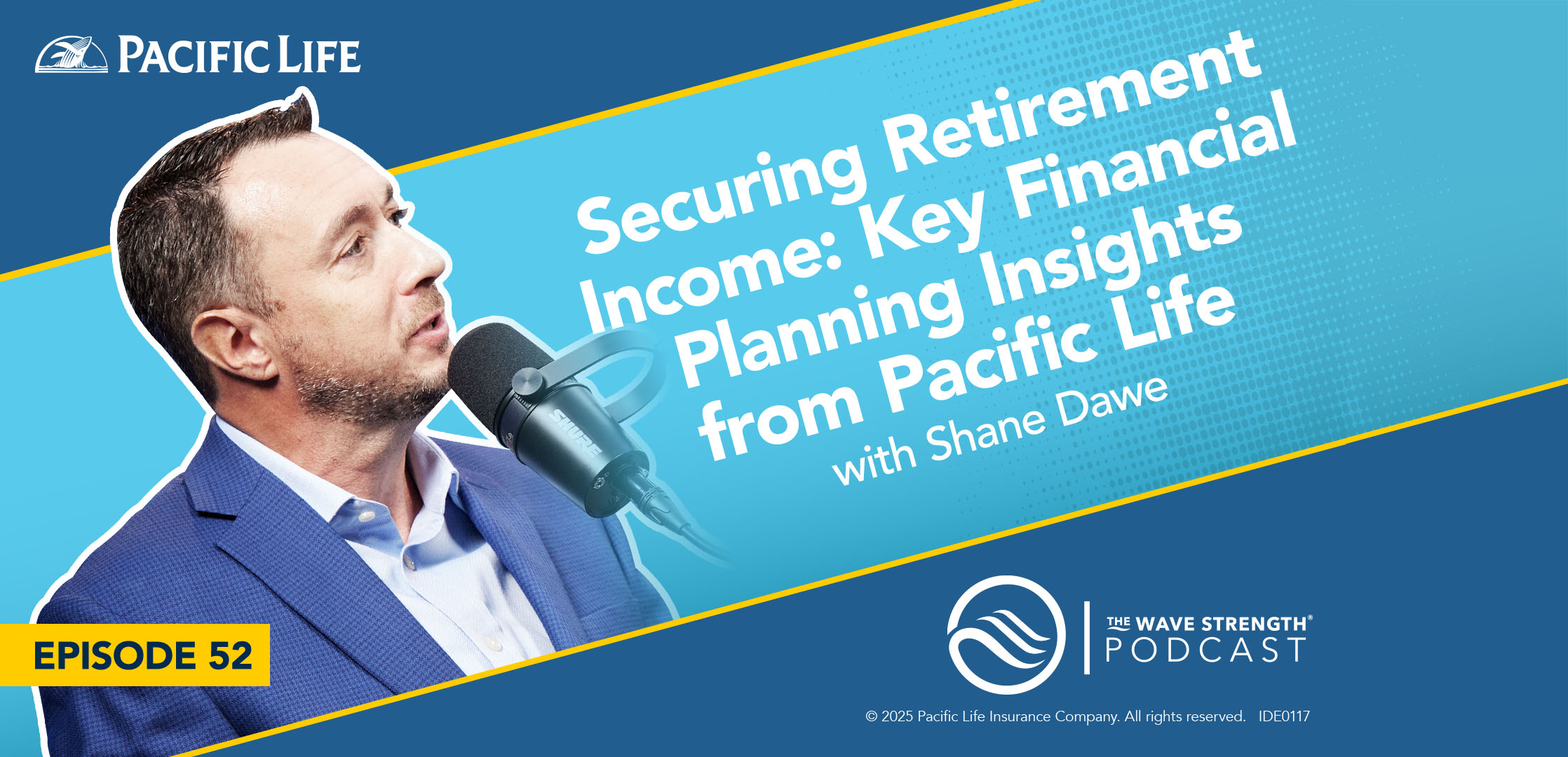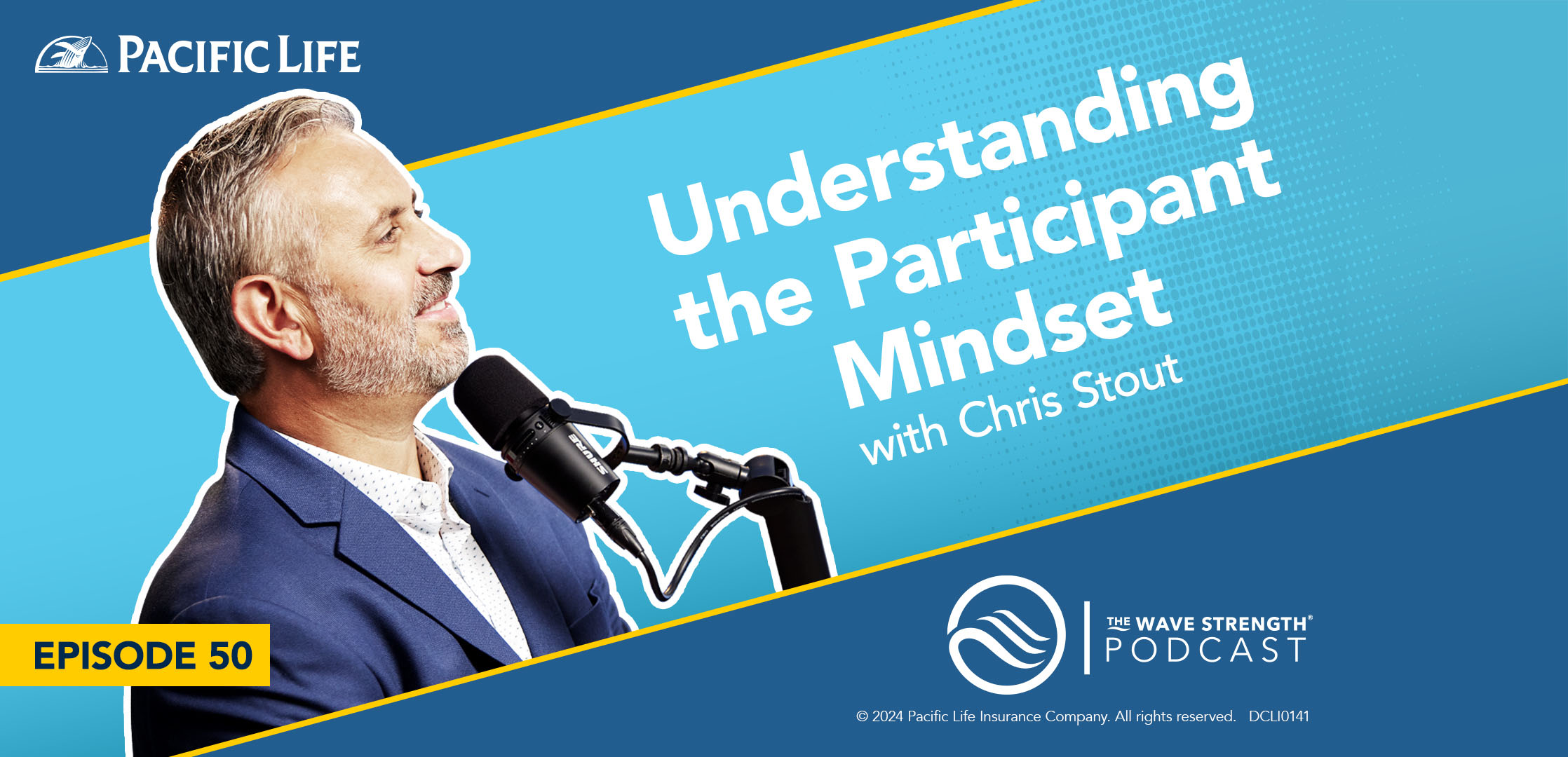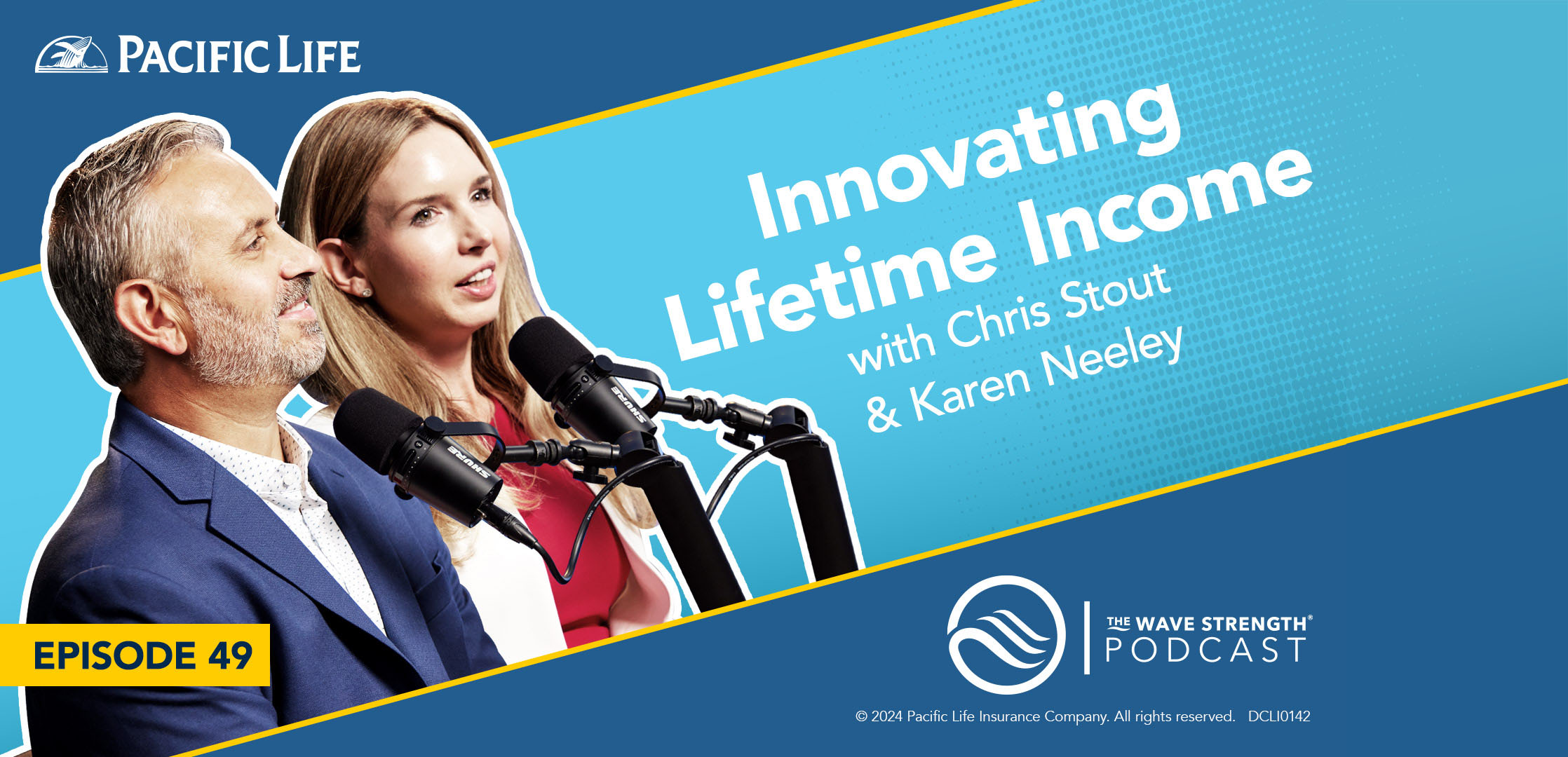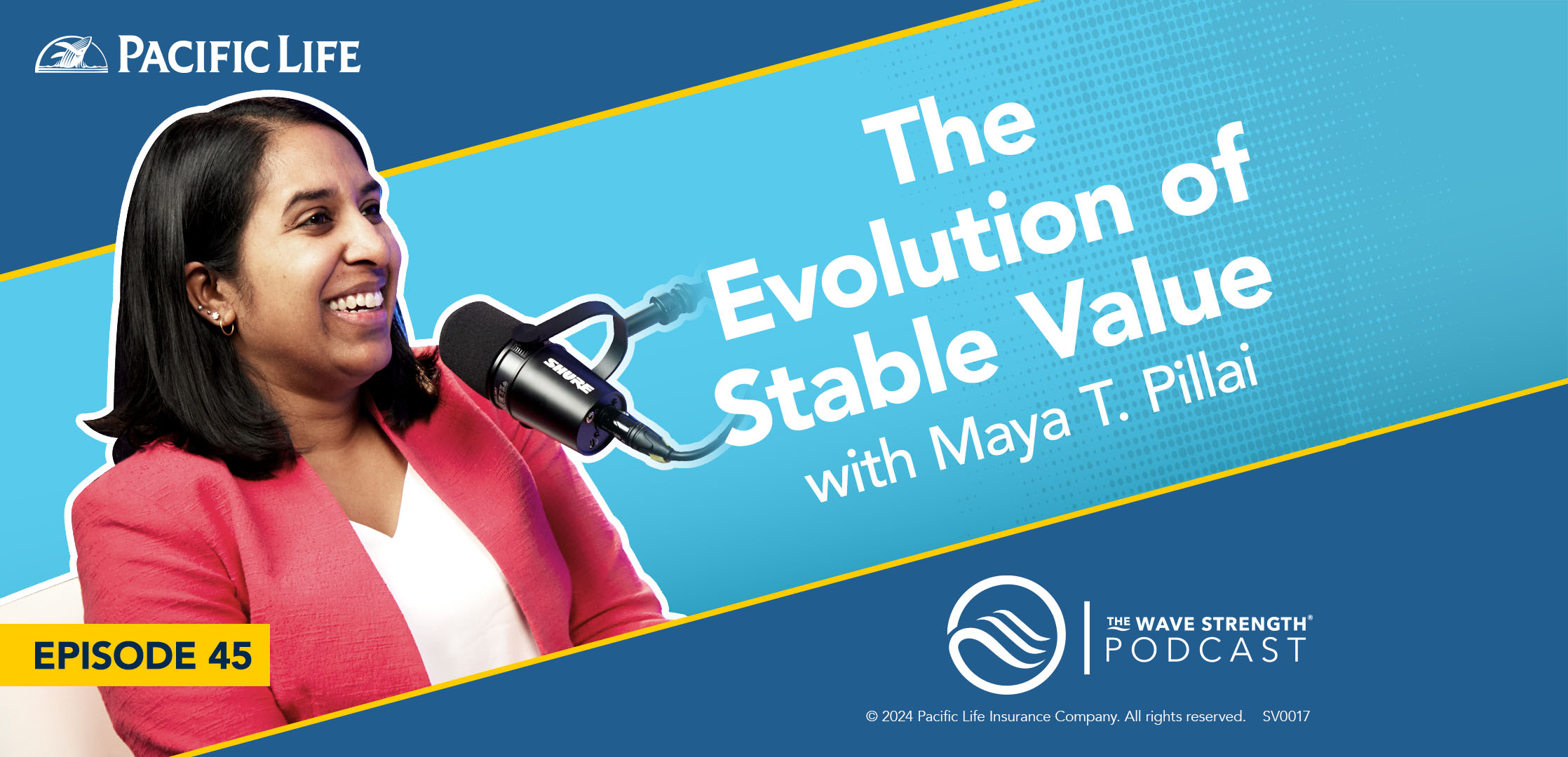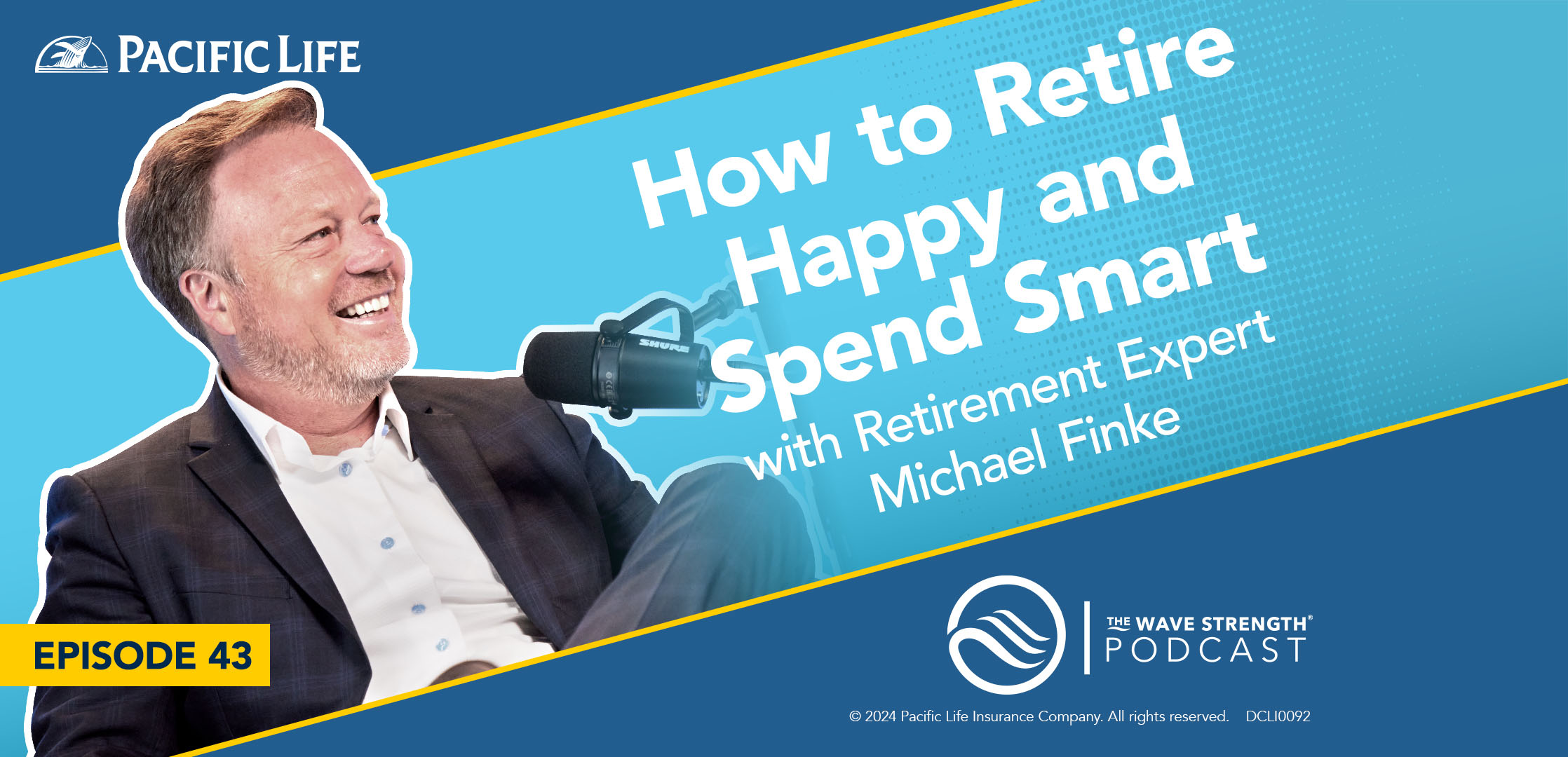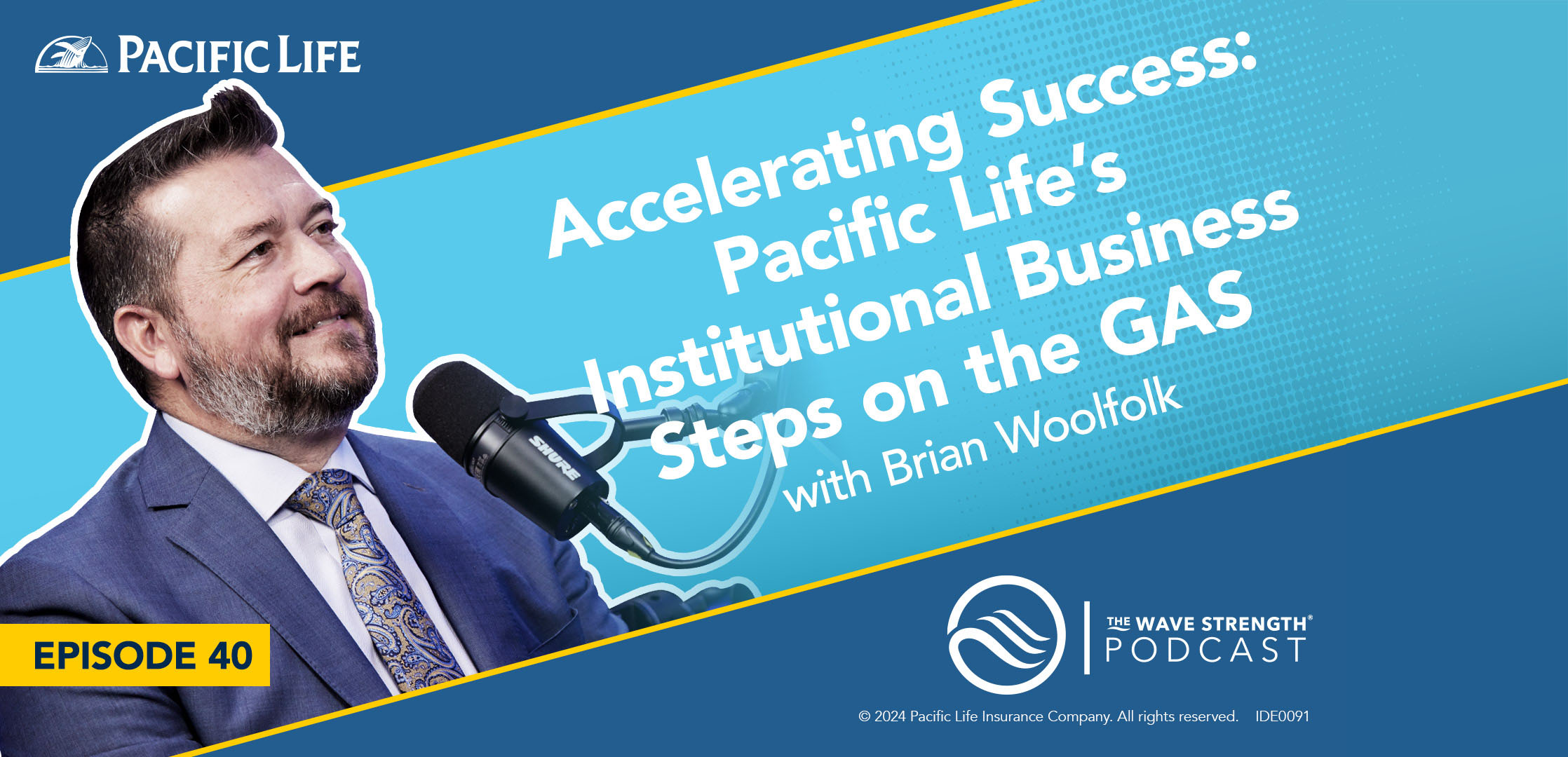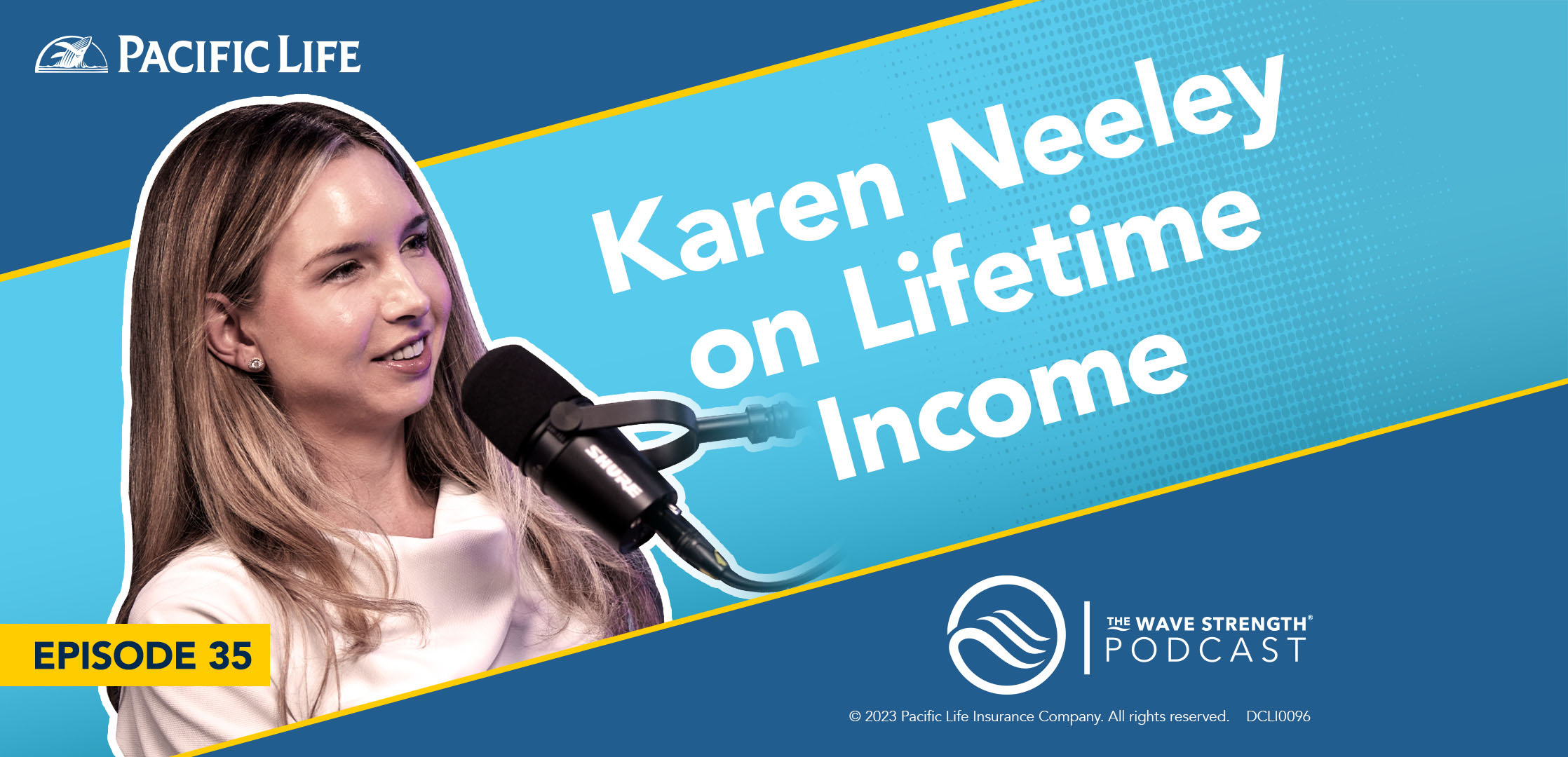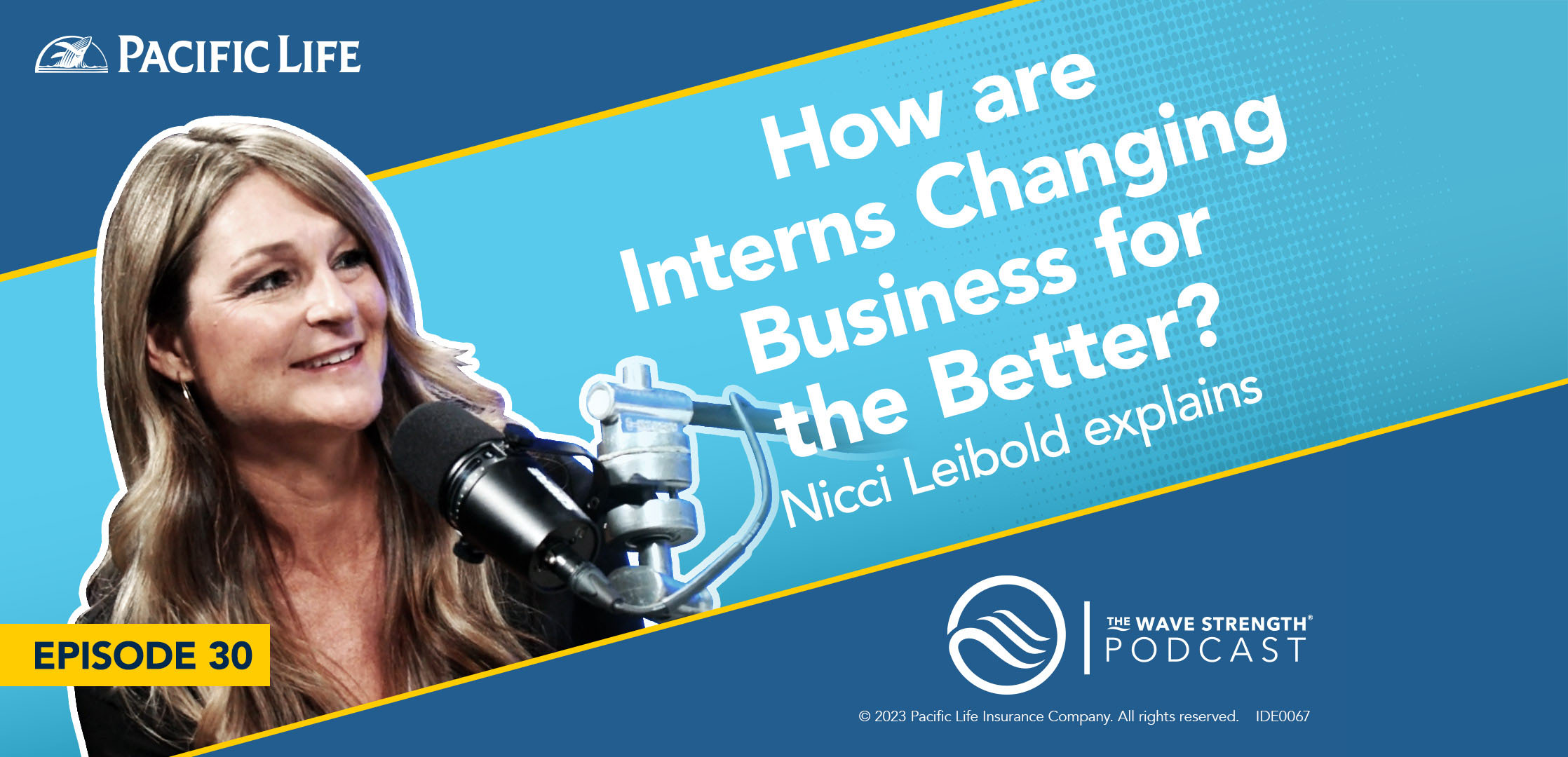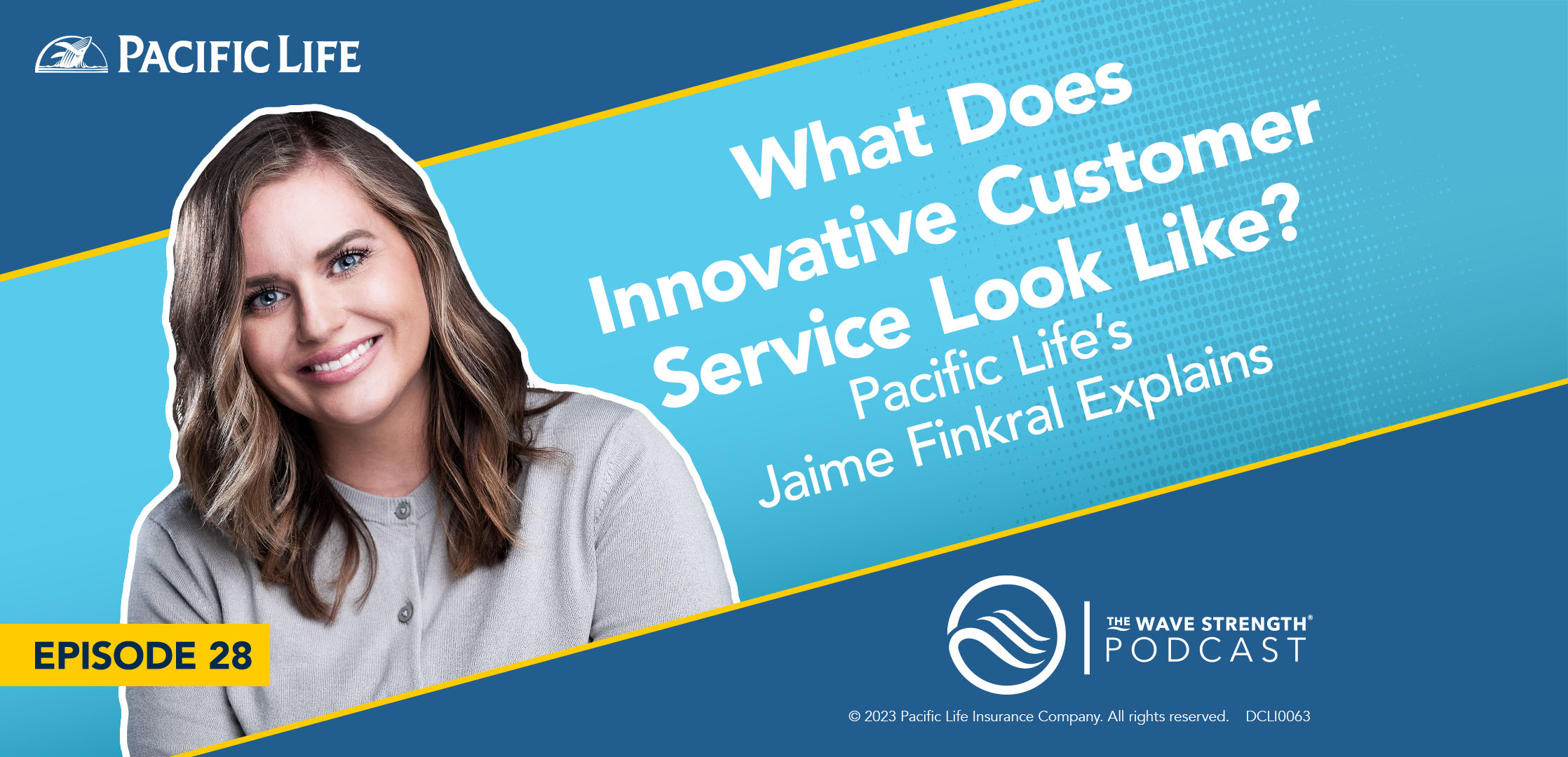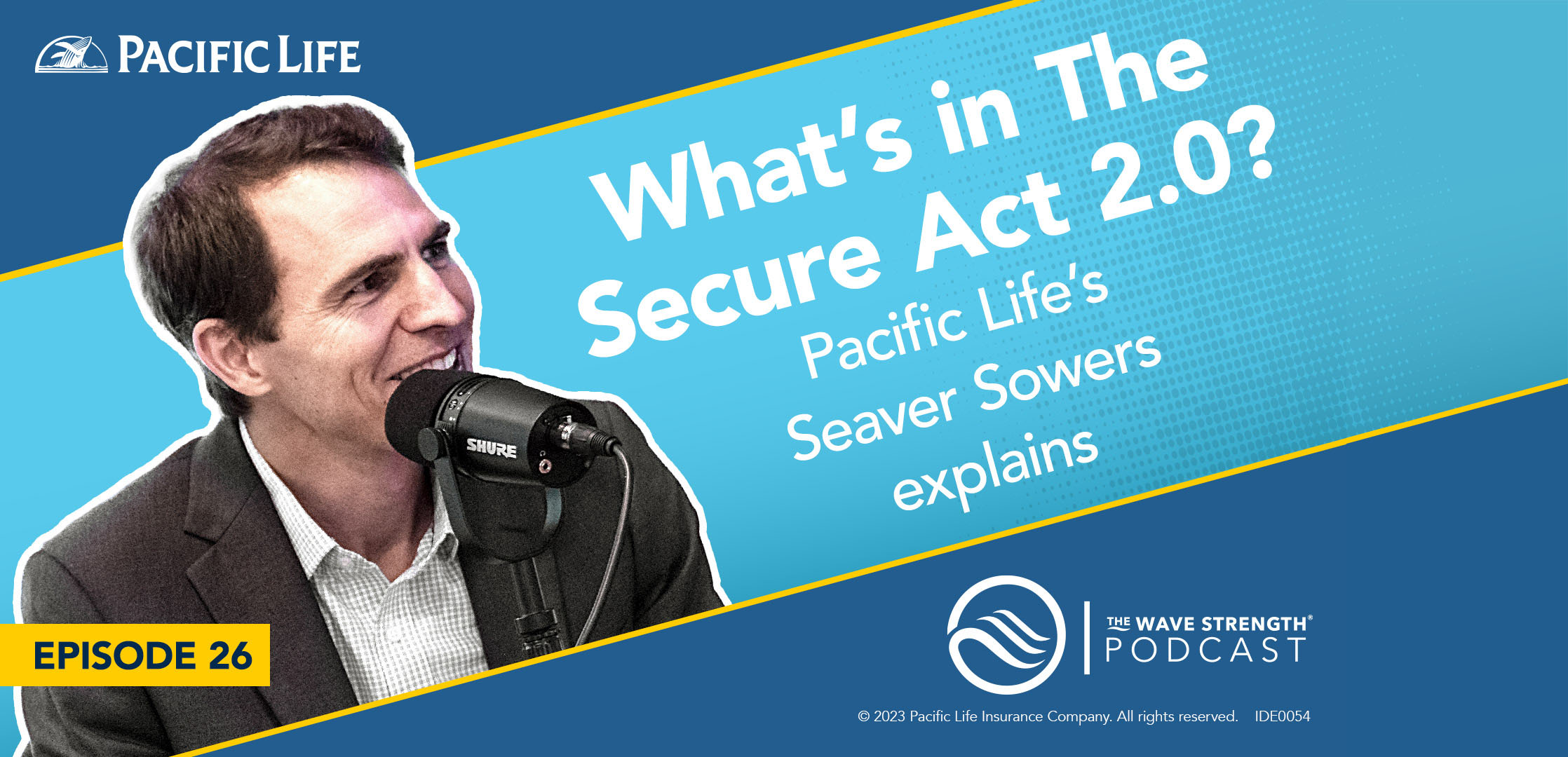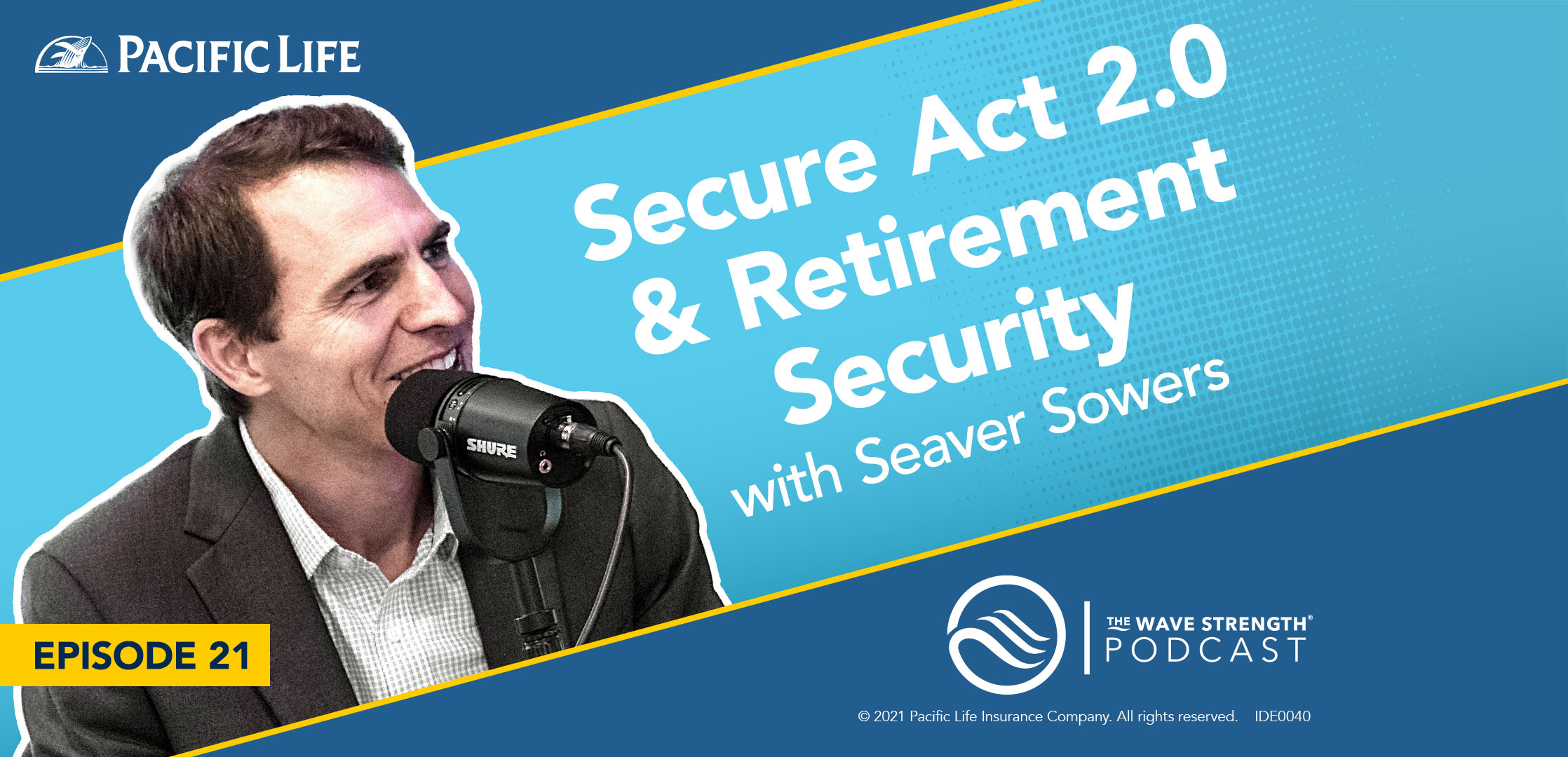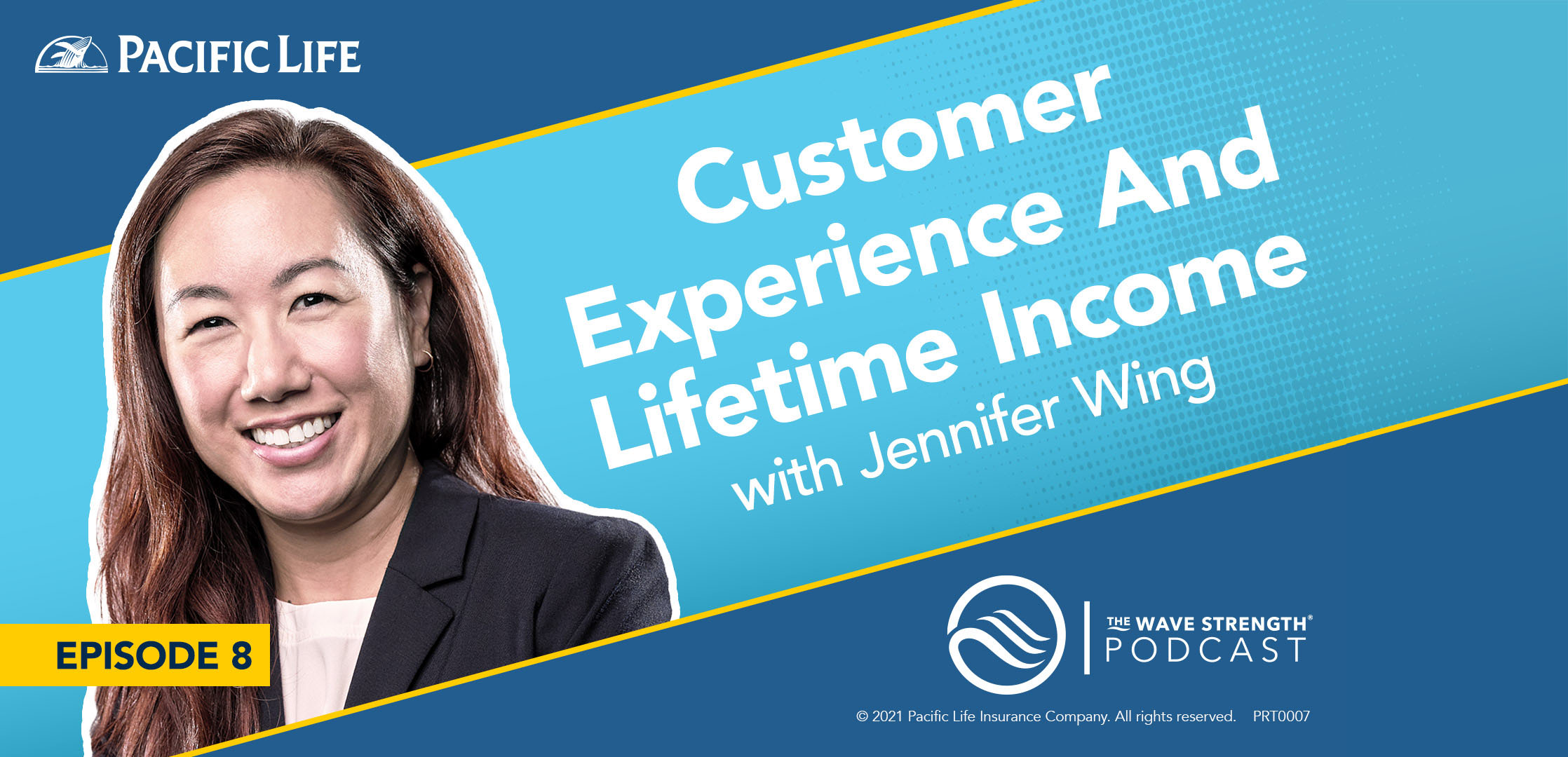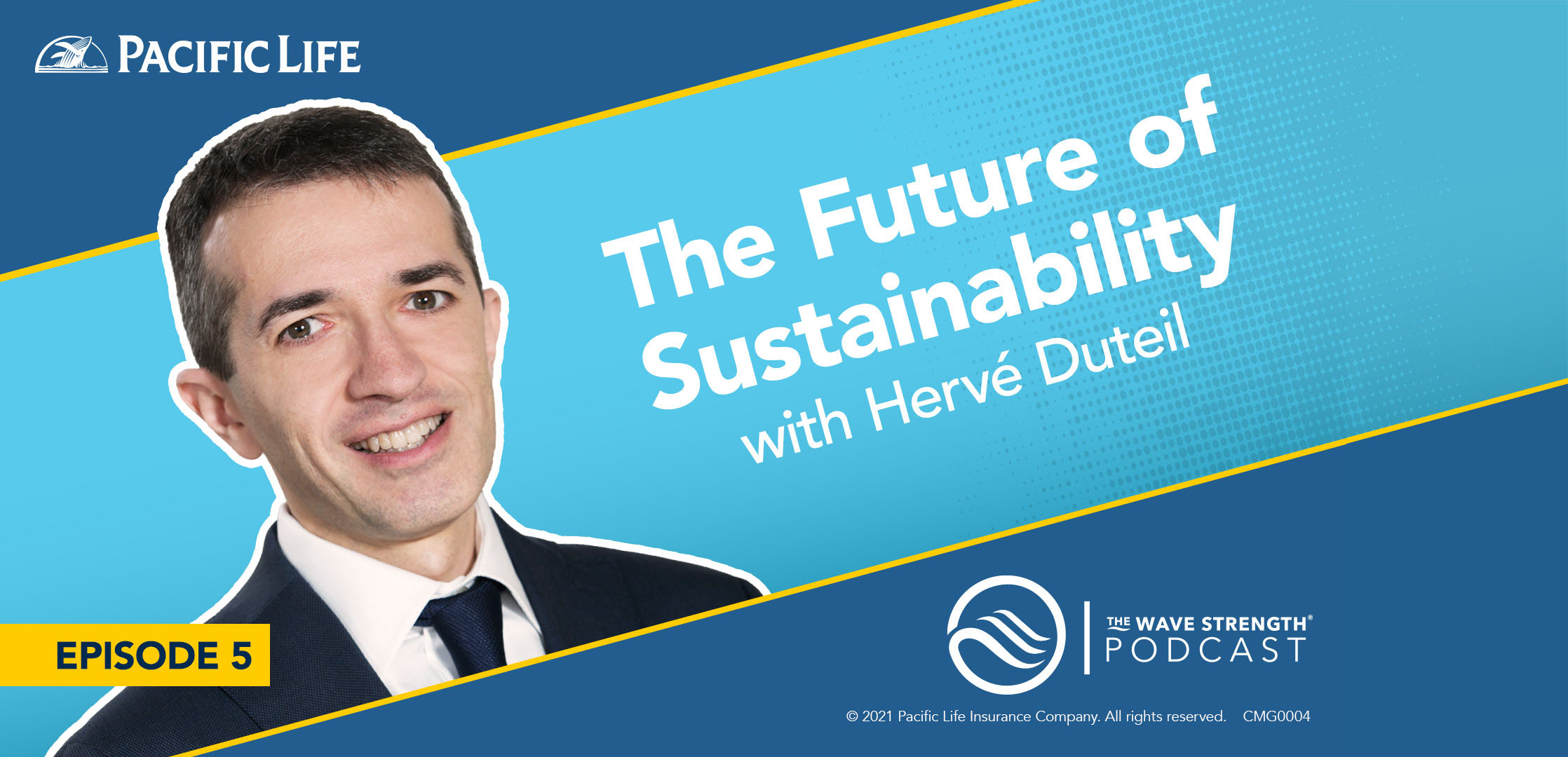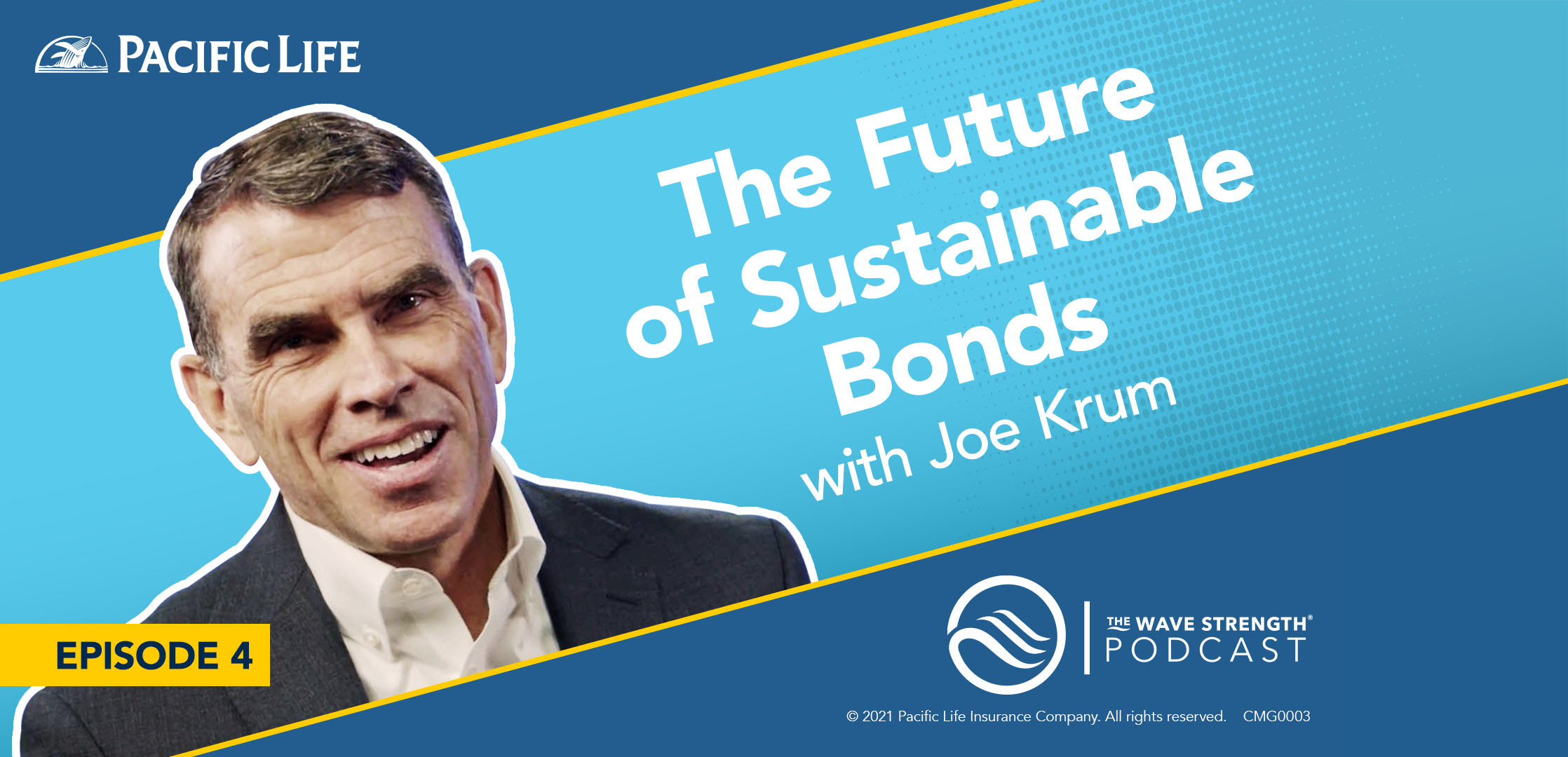Jim Breen: Navigating regulatory changes.
Will Hansen: They have already done a great job of, prioritizing guidance.
Jim Breen: Using data analytics to help inform personalization.
Will Hansen: That's the type of data that I think, our plan sponsors, our HR professionals are more interested in is like getting that more granular look at, how their plan is running and how they can make it run even better.
Jim Breen: And legislative advocacy.
Will Hansen: How do we ensure that more Americans have access to a retirement plan?
Jim Breen: All this and more on today's episode of The Wave Strength.
VO: Welcome to The Wave Strength, innovative solutions for a secure retirement presented by Pacific Life.
Jim Breen: Hello everyone. And welcome to another episode of The Wave Strength podcast series. I'm your host, Jim Breen, head of marketing with Pacific Life's institutional team. We are joined here today in the studio, live with Will Hansen.
Jim Breen: Will is the Chief Government Affairs Officer for the American Retirement Association. Will, I want to thank you for once again, joining us in the studio, to have another conversation.
Will Hansen: No, thanks for having me back again.
Jim Breen: Yeah, it's been great. we've already, had some fantastic, discussions, one of which, was with, our head of the Institutional Retirement Solutions Group, Karen Neeley, just a moment ago, a great one on education and the plan sponsor.
Jim Breen: We've talked about the mindset of the plan sponsor. I want to encourage our audience to head over to YouTube, Audible and Spotify, hit and subscribe, and also search for those episodes I just mentioned. And when you like, and you subscribe, you can stay current as new content becomes available, but let's jump into the topic at hand for today's episode, which is discussing the regulatory landscape for the plan sponsor, which it sounds heavy. That sounds, there's a lot there. and, we have a, good amount of content to go through here, Will, but before we began the episode, we were chatting and you asked me, you said, Jim, what is it that we can maybe start off with?
Jim Breen: What can I answer? and something that I would love to, to ask you, Will, is maybe you can help our viewers understand. Why it is important that you are there in Washington, in your role, making a difference and what is it that, that you're there doing, to support, these plan sponsors and to, be an advocate for, retirement wellness.
Will Hansen: Yeah, every industry needs an advocate, and every industry in DC has representation, and so I just happened to utilize my background as a, recovering Hill staffer and a recovering HR professional to become that advocate, in Washington DC, along with our team at the American Retirement Association, and our, our mission is to ensure that every working American has access to a workplace retirement, savings plan. You are 12 times more likely to save for retirement if you have access to a retirement plan at work, so first and foremost is we want to make sure people have access to that retirement plan at work.
Will Hansen: And then second, we want to improve upon the system that's already, in place. Retirement policy is one of the very few bipartisan, policy areas in Washington, D. C. We've had two major bills passed, Secure 1. 0 and Secure 2. 0 in the past handful of years, and they've been done in a bipartisan manner.
Will Hansen: So that's, from my perspective, it's enjoyable for me to be able to work with, both parties, as well as independents, to get, just smart retirement policy across the finish line and that's, what we do at the American Retirement Association.
Jim Breen: Thank you for all that you do, it's an important, it's important work. And as you mentioned, one of the few bipartisan endeavors, there on the Hill, I'm sure you have a lot of interesting stories, and, can't talk about it. Yeah, you can't talk about it. but, but that's good in, in knowing that kind of setting the stage for what we're going to discuss today.
Jim Breen: I'd like to talk a little bit about, navigating some of these regulatory changes. You talked a little bit about Secure one and two, maybe you can provide a quick overview of the current landscape as it pertains to, to regulatory, engagement and any kind of, new regulatory advancements we may see in the future.
Will Hansen: Yep, so right now we are a hundred percent focused really on Secure 2. 0, so now that the law has passed, it has been, delegated to the regulatory agencies, mainly the Department of Labor, or the Treasury Department and the Internal Revenue Service, to then issue guidance on the 92 provisions that were in Secure 2. 0, they have already done a great job of prioritizing guidance, getting out the guidance that is, needed right away or sooner than later compared to some of the other, provisions, and so that's what we've seen really over the past, few months. From the plan sponsor angle. I think,
Will Hansen: what folks, if you're listening in, you're an HR professional, you're overseeing your plan, one thing to keep in mind is that all of the provisions, really except for one or two, were optional. So there's nothing that you need to do right now, unless, you're getting pressure or you think that, one of those provisions would just be really cool to implement, in your 401k plan.
Will Hansen: So, that is what we're waiting for right now is guidance from treasury or labor, to help implement some of those more optional provisions that are out there. The primary, not optional, but mandatory, provision in there, is the, provision that, your catch -up contributions need to be, in Roth, not pre tax, if you make over a certain dollar threshold per -year, that is, been delayed. and it's not effective again for another year or so. but there still is some guidance that I think we're looking for so that the industry can properly implement, that specific provision.
Jim Breen: Interesting, and, talking a little bit about how one can be compliant, let's talk about best practices for compliance.
Jim Breen: Maybe there are some specific strategies, that you can talk about how one could stay compliant in education, a lot of the resources that PSCA and ARA have available, I'm sure would be a benefit as well.
Will Hansen: Yep. Oh, definitely. first is education, obviously. educate yourselves, first off, as we've talked about in some prior episodes, just on the basics of your 401k plan.
Will Hansen: So, the certified plan sponsor professional credential that we've talked about, one way to learn, the basics, but then yes, how do you stay on top of, oncoming or on, regulations that are coming out, or new laws even. And that is, first I can be biased and say through our association.
Will Hansen: So whether it's Plan Sponsor Council of America that I'm also executive director of, or NAPA, The National Association of Plan Advisors or any one of the other great associations that are out there in the retirement space, are pushing out materials to help you better understand, these regulatory changes, these legal changes, or these, legislative, changes.
Will Hansen: But, Beyond that, I think most of the great companies that are out there, whether it's your consultants, your advisors, your record keepers, or, others in the retirement sphere, look to them. If you're a plan sponsor, if you're a HR professional, if you're a financial advisor, use other resources that you have out there, not only the associations, but others.
Will Hansen: And tap into those, there's tons of free stuff out there. There's great webinars, content, magazines for you to just stay up to speed, on a lot of those new guidance.
Jim Breen: Yeah, a lot of great resources in the episode, that we recorded earlier with Karen Neeley. we talked somewhat about those resources.
Jim Breen: You did mention a couple of websites. Also, if you wouldn't mind mentioning the PSCA website, just for folks who may be interested in learning more about those resources on the site.
Will Hansen: Yeah. PSCA. org. so Plan Sponsor Council of America, definitely check it out. You just go to the education, tab and learn more about some of the services that we provide, most of which are complimentary, to our members and you become a member by getting the credential, the certified plan sponsor professional credential, so definitely check out PSCA.org to learn more about how you can, go through that complimentary, fiduciary education that we provide.
Jim Breen: And you talked about, the, the certificate program and there's other resources as well, including the data, the longstanding data that, I think is over 50 years old, that research platform that you have, perhaps you can share a little bit about that and the benefits of that survey.
Will Hansen: Yeah, so we have our annual survey, the one that's going to be, released actually later this year will be the 67th, edition of that survey longer, or I guess older than 401k plans, but mainly focused on defined contribution type plans. If you're a plan sponsor, if you're an HR and you complete the survey, unfortunately it is closed at this time for this year, but next year, if you complete it, you get a free copy.
Will Hansen: So, free copy, 200 tables, tons of information so that when you're talking to the C suite, you're in your investment committee meeting and someone asks a question, about comparing yourself to your peers, to your competitors. You probably have the answer for it in that book, but also if you're interested in HSAs, non qualified plans, or if you have a 403b plan, not a 401k, we have those annual surveys too.
Will Hansen: But one resource that is really important that's actually, you can access even if you're not a member is we do a question of the week. So it's one question, simple answer, yes, no, maybe it's multiple choice, and it's really checking in on the pulse of the plan sponsors on a variety of topics. and you can look at it, and see, and it's broken up by topic, where are your peers, your friends in HR thinking about X, Y, Z provision that's in Secure 2. 0, or where are your peers on, lifetime income products? you can go to our website, PSCA.org, find that question of the week tab and, just, learn more about what plan sponsors are thinking.
Jim Breen: That's great. And we're talking a little bit about technology and how you're utilizing, your, web platforms to promote the survey.
Jim Breen: And, maybe we can talk a little bit more about technology and the role of technology in plan administration, whether it's plan administration, emerging technologies, and utilizing those in the administration side of things, or even just like from an educational standpoint, before the show, we were talking a little bit about
Jim Breen: technology implementation, as it pertains to how we, communicate this actual broadcast, but maybe your thoughts Will, about how these new technologies are really revolutionizing the, the landscape of, retirement solutions.
Will Hansen: I mean, I will totally be honest and say, I use an AI platform a lot, to educate myself or to just make my job a little bit easier.
Will Hansen: But it is, it is, everyone should just admit that you've used it, in some form or fashion.
Jim Breen: My good friend, Chat Gptuh.
Will Hansen: Yeah, exactly, so it's, and it's, but it is education and, I am sometimes asking what you just said, a specific question, to educate myself or to, more quick, quickly synthesize, some sort of, topic.
Will Hansen: and so I think, just because of A. I., generically, we are seeing a lot of advancements, in the retirement space. So I do think down the road, plan sponsors are going to need to, understand, first and foremost, the basics of AI. We had a great general session conference at, PSCA national this year, a few months ago that was just on AI and it was more of a, let's take a step back and just understand what is AI.
Will Hansen: But then as a, from a plan sponsor, what do I need to be concerned about? And how do I protect the company? How do I protect my employees or just how do I use it to, more effectively, educate my employees? And so I think we're at the very early stages now, but I do think down the road when it comes to, investment advice is always, one go to, there, how to, maybe alter some of the education materials in a different manner for a different group of employees, because everyone's, you have a diverse workforce.
Will Hansen: You need to figure out how to meet your employee where they're at. And so you need to alter the education materials. You can probably use AI, to do that, plan administration. I think there's going to be a lot of interesting new products coming out online soon, that will help you administer your plan, a lot more effectively, by using or tapping into AI technology, as well.
Will Hansen: So, we're really at the early stages here, and so I'm pretty excited just about how we will be able to use it as long as you and I still have a job.
Jim Breen: Exactly, and Pacific Life is not currently, utilizing AI to build any products or solutions. However, the ability to be familiar and to, have awareness of these various platforms, right?
Jim Breen: Because AI is not just a thing. It is something that permeates currently into many different facets of technology, And, personally, I do believe that it will be something that, in even five to ten years, we won't say, Oh, that's AI. It's just going to be integrated in everything we do.
Jim Breen: And in some cases it already is, whether you're using some of these, bots like Grammarly or some of these other things that are looking through the, the text that you write perhaps, or if it is actually ChatGPT or, Microsoft Copilot, whatever it may be that you're utilizing.
Jim Breen: But, I had a conversation with somebody not that long ago. If you look back to the late nineties, when, folks really started to become more familiar with the internet and in the early two thousands, when Google became a bit of a mainstay, you had a lot of folks that were still, Oh my goodness, why would I ever want to go onto that box, the computer and type something in when I have this.
Jim Breen: Amazing yellow pages here when I can just page through and quickly find somebody in my area that is going to come and fix, my plumbing problem or will, come and help me with some, issues around the house or provide some sort of service, it's my area. Why would I want to get rid of this yellow page?
Jim Breen: Go onto a computer and type it in there. That's crazy, and all of a sudden, yes, we don't have the yellow pages or white pages at your doorstep. But what we do have is a multi billion dollar ad industry, that then is still, very vibrant and growing, with ad buys and ads, AdWords and et cetera, all over, whether it's Google or other platforms.
Jim Breen: So even though the white pages and yellow pages are no more, We now have a massive ad industry, right? Whether it's online ads, or any sort of digital ad that is no more in the printed form, but definitely in a digital form, be it our devices or desktops, et cetera. And so I believe that AI will be, along those lines, it will be integrated into what we do, and help us in, in, in so many ways that we just can't even fathom at the moment.
Will Hansen: And it will, and it's funny you mentioned that, example during COVID, I lived in a rural area for a little bit and I did use the yellow pages for a plumbing issue, and that was more effective than actually searching online, and that was only a few years ago.
Jim Breen: Where were you able to find the yellow pages?
Will Hansen: I had it. It had it, but to that end though, I think that's a prime example of we're still at the early stages. We do need to, again, not only, we talk about meeting the employee where they're at, from a retirement perspective, but also from a technology perspective too.
Will Hansen: And, not everyone's going to be comfortable, using AI or tech to, assist them, with their, retirement plan. but it's coming, and, I think we just have to embrace it.
Jim Breen: We do. And the governance is extremely important. And, and ways in which we can be effective with these AI tools, but it is coming and it will be something I think that is going to continue to revolutionize the way we live our lives, and the way we maybe look at our future selves.
Will Hansen: I agree, and you mentioned governance too, as an example, it is something that we also have to look at it from a regulatory or from a legislative, angle too, as AI is pushed out there, back in Washington, DC. there is going to be some, further, reviews of, how do we need to put some guardrails, on AI. And I think that's something that we also need to keep in mind down the road and maybe that will circle back to retirement as well. We're already look, working on a Secure 3. 0 package. So we had 1.0, 2.0, 3. 0 will be next, so who knows what will be included in that, but there might be some technology aspects, in that next piece of, legislation,
Jim Breen: We talked, the technology and, looking at data analytics and using that, the, those analytics to create a more personalized approach or for folks as they're in their retirement journey. What are your thoughts about using data to create that personalization?
Will Hansen: Oh, I love it. You got to use it data or data, whatever you use or however you say it. I constantly am asking, the plan sponsors that I work with, on a daily basis, like how they are utilizing, data and, how can they better access it?
Will Hansen: I think, a lot of the data or data that used to be, we looked at was, auto enrollments or it was, what's the participation rate, what's the average contribution rate and people still use that. But I think now HR professionals are recognizing that. All right. Let's dig in a little bit deeper.
Will Hansen: If I want to, participation rate's great, but if I want to increase it a little bit more, how do I do that effectively? So digging into the data to see, is there a specific cohort of employees, that are just not contributing? And can I angle my communications, my education towards that cohort of employees because they all fall into a certain bucket, whether it's a somehow socioeconomic bucket of sorts, to encourage them to participate? That's the type of data that I think, our plan sponsors, our HR professionals are more interested in is like getting that more granular look at, how their plan is running and how they can make it run even better?
Jim Breen: Looking ahead as we wrap up the episode here, Will,
Jim Breen: looking at that regulatory landscape, you mentioned potential rumblings of a SECURE Act 3. 0. Is there anything, on deck that you can share, or any, wisdom perhaps that you can provide as it pertains to the future of that regulatory landscape?
Will Hansen: Yeah. I'm already excited for Secure 3. 0. I think, again, it goes back to the mission of the American Retirement Association. How do we ensure that more Americans have access to a retirement plan? So that what I would see in a Secure 3. 0 is continuing on what Secure 2. 0 is doing is that ensuring that there are more small businesses in particular, have the tools to offer a retirement plan to their employees.
Will Hansen: And then from there, I'm ensuring that more Americans, even if they do have something at work, they are participating. So more ways to encourage people, to participate, that will be the theme I think of, Secure 3. 0.
Jim Breen: Fantastic, thank you so much, Will, and to our audience. If you're interested to learn more about these conversations with Will, head over to YouTube, Spotify, and Audible and search The Wave Strength.
Jim Breen: Hit and subscribe so you can be current with new content as it becomes available. Once again, thanks for joining us and have a great day, everyone.
VO: This has been another episode of The Wave Strength presented by Pacific Life. Don't forget to catch us on YouTube and make sure to subscribe. Although this podcast is presented by Pacific Life, the opinions and views expressed are those of the hosts and participants, and do not necessarily reflect Pacific Life's views on any of the topics discussed.
VO: Unless otherwise noted, Pacific Life is unaffiliated with any other individual or company mentioned. Pacific Life is a product provider. It is not a fiduciary, and therefore does not give advice or make recommendations regarding insurance or investment products. Pacific Life, its affiliates, its distributors, and respective representatives do not provide any employer sponsored qualified plan administrative services or impartial advice about investments and do not act in a fiduciary capacity for any plan.
VO: Pacific Life refers to Pacific Life Insurance Company and its subsidiary, Pacific Life Annuity Company. Insurance products can be issued in all states except New York by Pacific Life Insurance Company and in all states by Pacific Life Annuity Company. Product availability and features may vary by state.
VO: Each insurance company is solely responsible for the financial obligations accruing under the products at issues. This podcast was recorded on August 13th, 2024.
Jim Breen: Thanks for joining us on today's show. We'd love to hear from you join the conversation below and leave a comment on your thoughts on what the industry can do better for participants as it pertains to lifetime income solutions.
Jim Breen: And if you'd like more interesting content, click one of these links over here.


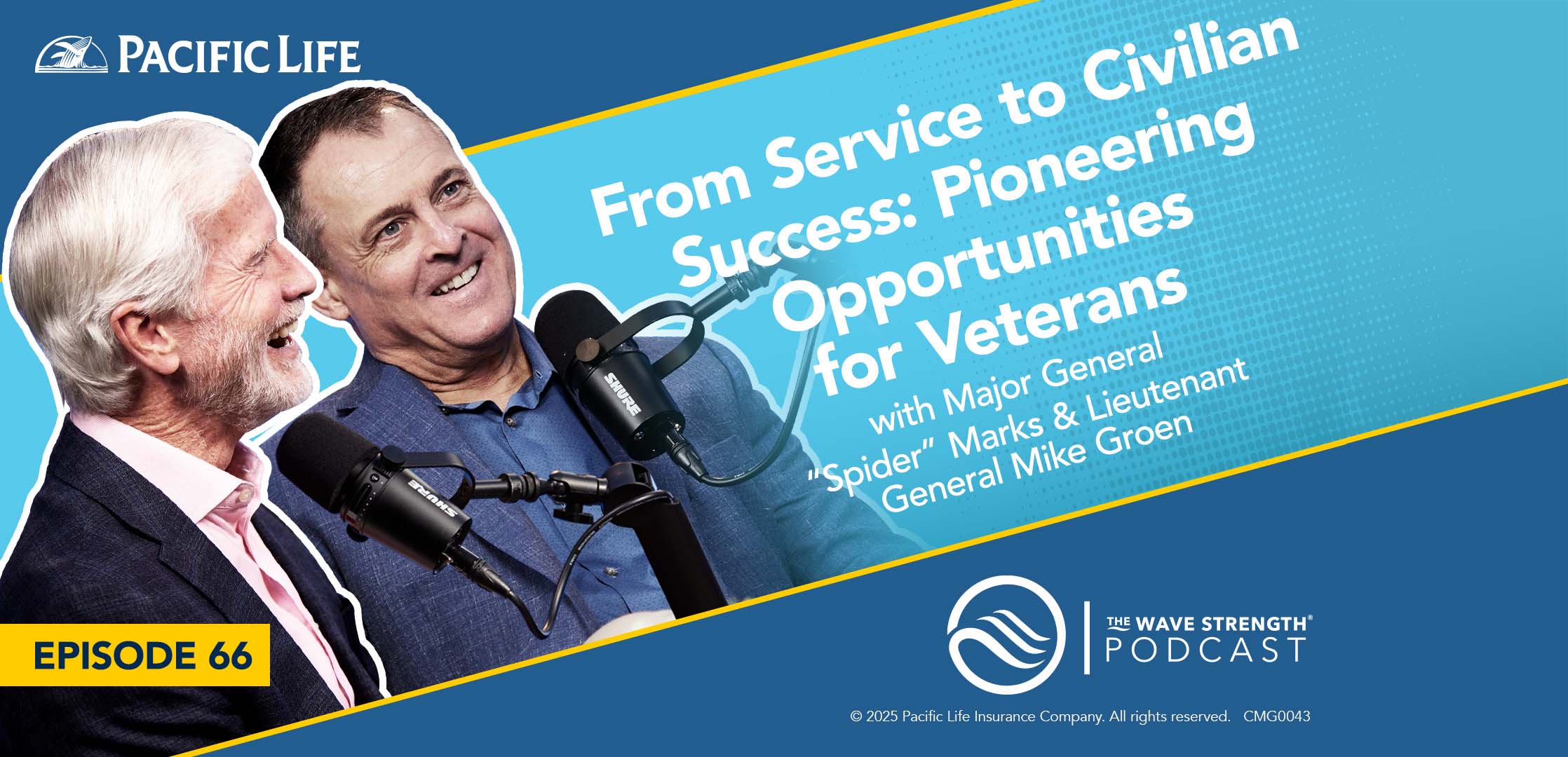
.jpg)
